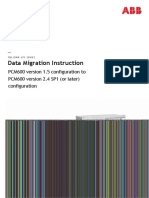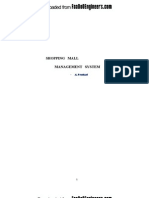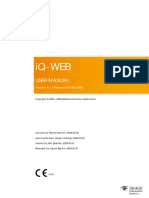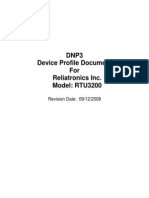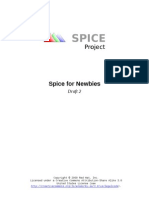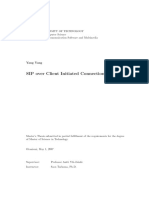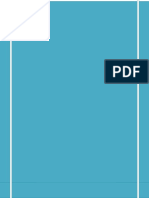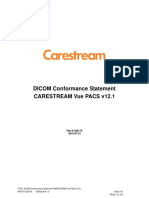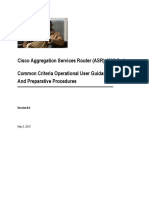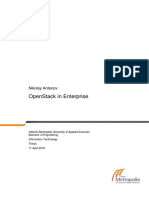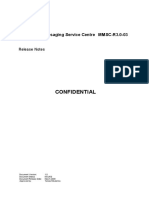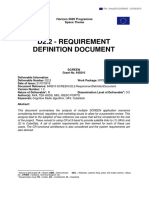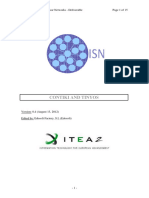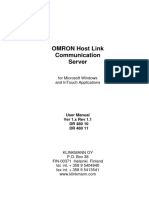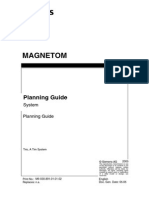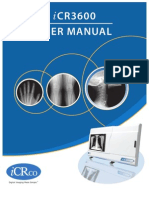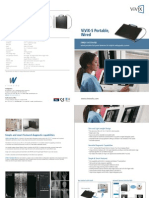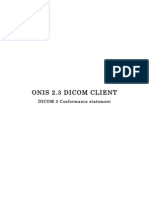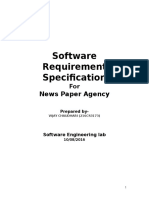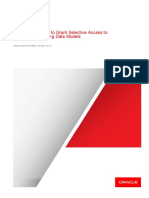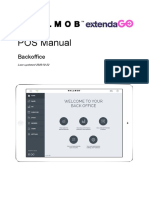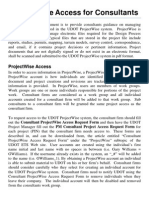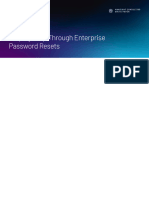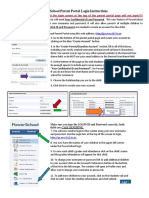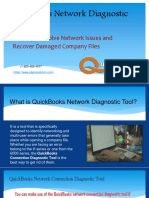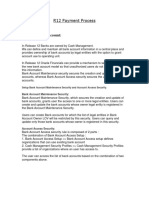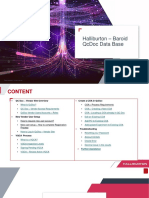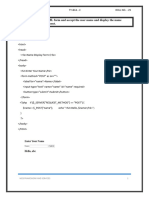Pacsone Server User'S Manual
Pacsone Server User'S Manual
Uploaded by
jand_20Copyright:
Available Formats
Pacsone Server User'S Manual
Pacsone Server User'S Manual
Uploaded by
jand_20Original Title
Copyright
Available Formats
Share this document
Did you find this document useful?
Is this content inappropriate?
Copyright:
Available Formats
Pacsone Server User'S Manual
Pacsone Server User'S Manual
Uploaded by
jand_20Copyright:
Available Formats
PacsOne Server Users Manual
For PacsOne Server Premium Edition
Author(s): Xiaohui Li Revision: 6.2.2
Copyright 2003-2010 RainbowFish Software
GLOSSARY AE AET PACS DICOM DMWL FSC FSR HIPAA HL7 HTML HTTP LUT PHP NEMA NTLM SCP SCU SMTP SOP SR UID UNC Application Entity Application Entity Title Picture Archive and Communication System Digital Imaging and Communications in Medicine Dicom Modality Worklist File Set Creator File Set Reader Health Insurance Portability and Accountability Act Health Level Seven Hyper-Text Mark-up Language Hyper Text Transfer Protocol Look Up Table PHP: Hypertext Preprocessor National Electrical Manufacturers Association (NT LanMan) is an authentication process that's used by all members of the Windows NT family of products Service Class Provider Service Class User Simple Mail Transfer Protocol Service-Object Pair Structured Report Unique ID Universal Naming Convention
Revision 6.2.2
Company Confidential
Page 2
Copyright 2003-2010 RainbowFish Software
Table of Contents
1 2 3 4 5 6 REVISION ...........................................................................................................................................................8 REFERENCE DOCUMENTS..........................................................................................................................10 INTRODUCTION .............................................................................................................................................11 PLATFORMS ....................................................................................................................................................11 INSTALLATION...............................................................................................................................................11 MANAGING PACSONE USER ACCOUNTS ...............................................................................................11 6.1 6.2 6.2.1 6.3 6.4 7 8 9 Privacy Attributes.....................................................................................................................................11 Creating New User Accounts ...................................................................................................................12 Creating Group User Accounts............................................................................................................15 Deleting Existing User Accounts..............................................................................................................16 Modifying Existing User Accounts ..........................................................................................................17
SYSTEM CONFIGURATION .........................................................................................................................17 SMTP SERVER CONFIGURATION .............................................................................................................20 SYSTEM JOURNAL LOG...............................................................................................................................21 9.1 9.2 Automatic Monthly System Journal Log Emails......................................................................................22 Automatic Purging Aged System Journal Log .........................................................................................22 APPLICATION ENTITY TABLE...............................................................................................................23
10
10.1 SCU Application Entities .........................................................................................................................26 10.2 SCP Application Entities ..........................................................................................................................28 10.2.1 Modality Worklist SCP Application Entities:......................................................................................29 10.2.1.1 Pre-Fetching of Dicom Studies for Scheduled AE Station.........................................................30 10.2.2 Query/Retrieve SCP Application Entities:...........................................................................................30 11 12 13 HL7 APPLICATIONS (OPTIONAL)..........................................................................................................30 SEARCHING PACSONE DATABASE ......................................................................................................31 NAVIGATING PACSONE WEB USER INTERFACE.............................................................................32
13.1 Login Page................................................................................................................................................32 13.2 Home Page (Todays Study Page)............................................................................................................33 13.3 Main Menu Bar.........................................................................................................................................34 13.4 Unread Studies Page.................................................................................................................................35 13.5 Browse Page .............................................................................................................................................35 13.6 Study Page................................................................................................................................................37 13.7 Series Page ...............................................................................................................................................38 13.8 Study Notes Page......................................................................................................................................40 13.9 Structured Reports ....................................................................................................................................41 13.10 Image Page (Thumbnail) ..........................................................................................................................43 13.11 Image Page (Full Size) .............................................................................................................................44 13.12 Image Notes Page .....................................................................................................................................45 13.13 Online Image Processing Page .................................................................................................................46 13.14 Tools Page ................................................................................................................................................48 13.14.1 Custom Data Element Coercion......................................................................................................48
Revision 6.2.2
Company Confidential
Page 3
Copyright 2003-2010 RainbowFish Software
13.14.2 Exporting Patients/Studies ..............................................................................................................50 13.14.3 Importing External Patients/Studies................................................................................................51 13.14.4 Statistics Reports.............................................................................................................................52 13.14.4.1 Automatic Statistics Reports via Email......................................................................................53 13.14.5 Automatic Purging Archive Directories..........................................................................................53 13.14.5.1 Automatic Purging By Dicom Data Element Filters ..................................................................55 13.14.6 Check Duplicate Patient IDs ...........................................................................................................56 13.14.7 Todays Log File.............................................................................................................................59 13.14.8 Upload Dicom Image ......................................................................................................................59 13.14.9 Matching ORM Message (Optional)...............................................................................................60 13.14.10 Database Integrity Check ................................................................................................................61 13.14.11 Import Worklist...............................................................................................................................62 13.14.12 Live Monitor (for System Administrator only)...............................................................................64 13.14.13 Patient Reconciliation .....................................................................................................................64 13.14.14 Anonymization Templates ..............................................................................................................65 13.15 Profile Page ..............................................................................................................................................66 13.16 Modality Worklist Page............................................................................................................................67 13.16.1 Enter New Worklist Page................................................................................................................68 14 15 16 16.1 16.2 17 18 FORWARDING IMAGES............................................................................................................................69 POST-RECEIVE IMAGE COMPRESSION..............................................................................................70 AUTOMATIC ROUTING ............................................................................................................................72 Dicom Image Routing ..............................................................................................................................72 HL7 Message Routing (optional) .............................................................................................................74 PRINTING IMAGES ....................................................................................................................................75 JOB STATUS PAGE.....................................................................................................................................76
Revision 6.2.2
Company Confidential
Page 4
Copyright 2003-2010 RainbowFish Software
List of Figures
Figure 1 User Accounts Administration ......................................................................................................................13 Figure 2 Creating New User Account..........................................................................................................................14 Figure 3 Creating Group User Accounts .....................................................................................................................16 Figure 4 Modifying Existing User Account.................................................................................................................17 Figure 5 System Configuration Page ...........................................................................................................................19 Figure 6 Configuring SMTP Server.............................................................................................................................21 Figure 7 System Journal Log.......................................................................................................................................22 Figure 8 Adding a New Application Entity .................................................................................................................25 Figure 9 Application Entity Table Page ......................................................................................................................26 Figure 10 Search Remote PACS Database ..................................................................................................................28 Figure 11 HL7 Applications (optional) .......................................................................................................................31 Figure 12 Search PacsOne Server Database ................................................................................................................32 Figure 13 Login Page ..................................................................................................................................................33 Figure 14 Home Page (Todays Study Page)...............................................................................................................34 Figure 15 Unread Studies Page....................................................................................................................................35 Figure 16 Browse Page................................................................................................................................................36 Figure 17 Study Page...................................................................................................................................................37 Figure 18 Series Page ..................................................................................................................................................39 Figure 19 Add Study Notes .........................................................................................................................................40 Figure 20 Study Notes Page ........................................................................................................................................41 Figure 21 Structured Report Page................................................................................................................................42 Figure 22 Image Page (Thumbnail) .............................................................................................................................43 Figure 23 Image Page (Full Size) ................................................................................................................................44 Figure 24 Add Image Notes.........................................................................................................................................45 Figure 25 Image Notes Page........................................................................................................................................46 Figure 26 Online Image Processing Page ....................................................................................................................47 Figure 27 Tools Page...................................................................................................................................................48 Figure 28 Data Element Coercion Page.......................................................................................................................49 Figure 29 Export Patients/Studies Page.......................................................................................................................51 Figure 30 Warning Message for Importing without DICOMDIR ...............................................................................52 Figure 31 Statistics Report Page..................................................................................................................................53 Figure 32 Automatic Purging Archive Directories ......................................................................................................54 Figure 33 Automatic Purging By Dicom Data Element Filter.....................................................................................55 Figure 34 Checking Duplicate Patient ID....................................................................................................................57 Figure 35 Resolving Duplicate Patient ID ...................................................................................................................58 Figure 36 Today's Logfile Page...................................................................................................................................59 Figure 37 Upload Dicom Image Page..........................................................................................................................60 Figure 38 Matching ORM Message (optional)............................................................................................................61 Figure 39 Database Integrity Check ............................................................................................................................62 Figure 40 Import Worklist ...........................................................................................................................................63 Figure 41 Live Monitor page.......................................................................................................................................64 Figure 42 Patient Reconciliation Page.........................................................................................................................65 Figure 43 Anonymization Templates ..........................................................................................................................66 Figure 44 User Profile Page.........................................................................................................................................67 Figure 45 Modality Worklist Page ..............................................................................................................................68 Figure 46 Enter New Worklist Page ............................................................................................................................69 Figure 47 Forwarding Images......................................................................................................................................70 Figure 48 Compression Setting for JPEG Lossy Transfer Syntax...............................................................................71 Figure 49 Compression Setting for JPEG2000 Part-1 Lossless or Lossy Transfer Syntax..........................................71 Figure 50 Automatic Dicom Image Routing ...............................................................................................................73 Figure 51 Automatic HL7 Message Routing (optional) ..............................................................................................75 Figure 52 Printing to Remote Dicom Printer...............................................................................................................76
Revision 6.2.2
Company Confidential
Page 5
Copyright 2003-2010 RainbowFish Software
Figure 53 Job Status Page............................................................................................................................................77
Revision 6.2.2
Company Confidential
Page 6
Copyright 2003-2010 RainbowFish Software
List of Tables
Table 1 Revisions ..........................................................................................................................................................9 Table 2 Reference Documents.....................................................................................................................................10 Table 3 PacsOne User Privileges.................................................................................................................................15 Table 4 PacsOne Server User Categories ....................................................................................................................15 Table 5 Options Specific for Group Users...................................................................................................................16 Table 6 Application Entity Table ................................................................................................................................24 Table 7 Data Element Coercion Rule Patterns ............................................................................................................50
Revision 6.2.2
Company Confidential
Page 7
Copyright 2003-2010 RainbowFish Software
1 Revision
Date 1/3/2004 2/29/2004 5/28/2004 Revision 1.0 1.1 1.2 Author Xiaohui Li Xiaohui Li Xiaohui Li Reason Initial version Add section about Referring/Reading Physician Name matching for private patients/studies Add sections for new features including DICOM Structured Report, Modality Worklist Management Add sections for new features including exporting patients/studies to and importing external patients/studies from DICOM Media Storage Formatted media, custom data element coercion rules Add support for importing external raw image files without DICOMDIR directory record Add section for Automatic Purging Archive Directories Add section for Automatic Image Routing by Key Attributes Add section for printing to Dicom printers Add section for remote study synchronization Add option to move aged studies to a destination folder when running automatic study purge Add Routing By Schedule Window; Add option to compress exported content into ZIP files Add Statistics Reports, System Journal Log, SMTP Server Configurations Added Study/Image Notes, Upload privilege, Duplicate Patient ID Resolution page Update document revision numbering scheme; Add System Configuration Page Add HL7 Message Listener related pages; Add User Profile page; Updated Search, Tools and Image Thumbnails pages Add Unread Studies link to the Main Menu; Add Upload Directory settings to the System Configuration page Add Upload Dicom Image to the Tools page; Add Auto-Scan parameters and Thumbnail/FullSize Images Directories to the Configuration page; Add Preferred Transfer Syntax to the AE Configuration page Add Support for Group Users; Add Database Integrity Check to the Tools page Added support for Mac OS X Added section about Post-Receive Image Compression; Added Import Worklist to the Tools page Added Institution Name (0008,0080) to the supported Data Element Coercion table; Added support for Automatic Purging By Study Date and Date When Study Is Received; Added Live
7/15/2004
1.3
Xiaohui Li
7/30/2004 9/18/2004 10/8/2004 2/8/2005 4/5/2005 5/31/2005 7/10/2005 8/18/2005 11/6/2005 1/14/2006 5/11/2006
1.4 1.5 1.6 1.7 1.8 1.9 1.10 1.11 1.12 3.1.8 4.0.1
Xiaohui Li Xiaohui Li Xiaohui Li Xiaohui Li Xiaohui Li Xiaohui Li Xiaohui Li Xiaohui Li Xiaohui Li Xiaohui Li Xiaohui Li
7/10/2006
4.0.2
Xiaohui Li
11/20/2006
4.1.3
Xiaohui Li
1/29/2007 4/12/2007 7/15/2007
4.1.4 5.1.1 5.1.2
Xiaohui Li Xiaohui Li Xiaohui Li
10/18/2007
5.1.3
Xiaohui Li
Revision 6.2.2
Company Confidential
Page 8
Copyright 2003-2010 RainbowFish Software
01/28/2008
5.1.4
Xiaohui Li
04/23/2008
6.1.1
Xiaohui Li
07/10/2008
6.1.2
Xiaohui Li
12/18/2008
6.1.3
Xiaohui Li
06/28/2009
6.2.1
Xiaohui Li
12/28/2009
6.2.2
Xiaohui Li
Monitor and Patient Reconciliation pages to the Tools menu; Added support for Long-Term Archive Directory and Automatic Aging from Short-Term to Long-Term Archive Directories; Added Dicom Command Filtering for more granulated AE-level access control Added more Automatic Routing keys: Study Description (0008,1030), and Series Description (0008,103E); Added Enter New Worklist page for manually entering Modality Worklist data; Added Automatic Worklist Scan option to the System Configuration menu Added Immediate [From, To] Schedule option for Automatic Routing; Support multiple email addresses for registered users; Added a <Email JPG Image> button to the full-size image page to send converted JPG/GIF images via email Added Automatic Purging By Dicom Data Element Filter; Added checkboxes for enabling/disabling the daily, weekly or monthly statistics report and the system journal report emails sent to the Administrators email address; Added more Automatic Routing keys: Modality (0008,0060), and Modalities In Study (0008,0061) Added Study Reconciliation option to the Configuration page; Added detailed examples for Data Element Coercion rules; Added Monitor and Mark Study privileges configurable for individual users and groups; Changed the PostReceive Image feature to be configurable for each source AE Added Compression Ratio and Image Quality settings for JPEG lossy mode compression transfer syntaxes during Post-Receive Image Compression; Added command-level access control for Dicom Modality Worklist (DMWL) querying client applications; Added references to Oracle databases; Added Tools->Anonymization Templates page Added Storage Commitment Report SCP option to the Application Entity page; Added Purge By Source AE Title option to Toos>Automatic Purge Storage Directories page; Added Sending AE Title as a configurable option when defining Automatic Routing rules; Added Preferred Import Removable Media Drive, Preferred Import Destination Folder and Study/Image Notes Sharing settings to the Profile page Table 1 Revisions
Revision 6.2.2
Company Confidential
Page 9
Copyright 2003-2010 RainbowFish Software
2 Reference Documents
No. 1. Standards Digital Imaging and Communications in Medicine (DICOM) Version 3.0 PacsOne Server Installation Guide Version 2.3.1 of the Health Level Seven (HL7) Standard Date 2008 Description Part 1 through Part 16 of the 2008 DICOM 3.0 Standard PacsOne Server Installation Guide Version 2.3.1 of HL7 specifications
2. 3.
2010 1999
Table 2 Reference Documents
Revision 6.2.2
Company Confidential
Page 10
Copyright 2003-2010 RainbowFish Software
Introduction
PacsOne Server is a DICOM 3.0 compliant Picture Archive and Communication System (PACS) application, which consists of the following components: A DICOM protocol server for servicing requests for image storage, query and retrieval, forwarding, routing, printing images, and Dicom-formatted media interchange through import and export functions. MySQL or Oracle databases for managing image records and related patient, study, series information. Apache 2.x HTTP server and PHP scripting engine for presenting a web-based user interface for browsing and managing database records. ImageMagick PHP module for displaying Dicom images through client's web browsers. An optional HL7 Message Listener module for receiving and sending HL7 messages via Lower-Level Transport Protocol (LLTP)
4 Platforms
The following platforms are currently supported: Windows NT 4.0 Workstation or Server Windows 2000 Workstation or Server Windows XP Windows 2003/2008 Server Windows Vista/Windows 7 Linux (kernel version 2.6 or higher) Mac OS X (Release 10.4 or later) for Intel/AMD x86 or x86_64 processors
5 Installation
PacsOne Server software can be downloaded from the following URL: http://www.pacsone.net/download.htm Refer to the document PacsOne Installation Guide for detailed instructions about how to install/upgrade and set up PacsOne Server software.
6 Managing PacsOne User Accounts
After PacsOne Server software has been installed successfully for the first time, there are only two (2) default user accounts created for PacsOne: The super-user (root for MySQL or SYSTEM for Oracle databases), which is the Administrator account required to administrate user accounts and set up privilege levels for all users. The built-in system user account which you have created during PacsOne installation. This account is strictly for PacsOne Server internal use, and it is not recommended to use this account to access the PacsOne web user interface since it does not have any associated privilege levels.
6.1
Privacy Attributes
In order to be more compliant with Health Insurance Portability and Accountability Act (HIPAA), all patients and studies stored in the PacsOne database have one of the two (2) privacy attributes below:
Revision 6.2.2
Company Confidential
Page 11
Copyright 2003-2010 RainbowFish Software
Public: If a patients privacy attribute is Public, then all studies of this patient and all images within the studies of this patient can be accessed by any PacsOne user account, without any user privilege requirements. If a studys privacy attribute is Public, then all subsequent series of this study and all images within the series of this study can be accessed by any PacsOne user account, without any user privilege requirements. Private (Default): If a patients privacy attribute is Private, then all studies of this patient and all images within the studies of this patient can be accessed by only those PacsOne user account (s) with the View privilege, or those user accounts whose Last Name and First Name stored in the user profile match with either the Referring Physician Name or the Reading Physician Name, or those group users whose Group Description matches with the Institution Name of this patient. PacsOne users without the View privilege will not be able to access a Private patient or any study or images of the Private patient, unless the users Last Name and First Name stored in the user profile match with either the Referring Physician Name or Reading Physician Name, or the user belongs to a User Group whose Group Description matches with the Institution Name of the patient. If a studys privacy attribute is Private, then all subsequent series of this study and all images within the series of this study can be accessed by only the PacsOne user account (s) with the View privilege, or those user accounts whose Last Name and First Name stored in the user profile match with either the Referring Physician Name or the Reading Physician Name, or those Group Users whose Group Description matches with the Institution Name of this patient PacsOne users without the View privilege will not be able to access this Private study or any series or images of this study, unless the users Last Name and First Name stored in the user profile match with either the Referring Physician Name or Reading Physician Name, or the user belongs to a User Group whose Group Description matches with the Institution Name of this study. All patients and studies are stored as Private when they are received by PacsOne. Only PacsOne users with Modify privilege can change the privacy attribute of a patient or study from Private to Public or vice versa. Changing a patient from Private to Public will implicitly change all studies of the patient to Public, regardless of their previous settings. Changing a patient from Public to Private will implicitly change all studies of the patient to Private, regardless of their previous settings. Changing a study from Private to Public does not affect the privacy setting of the patient who this study belongs to, except when this study is the only study of the patient. The patient will also be changed from Private to Public if and only if the study being changed is the only study of that patient. Changing a study from Public to Private does not affect the privacy setting of the patient who this study belongs to, except when this study is the only study of the patient. The patient will also be changed from Public to Private if and only if the study being changed is the only study of that patient.
6.2
Creating New User Accounts
Only the Administrator/Super-user (root for MySQL or SYSTEM for Oracle databases) can create new user accounts, after logging into PacsOne by accessing the following URL: http://{HOSTNAME}/pacsone/home.php Where: {HOSTNAME} is the name of the machine where PacsOne is installed, e.g., localhost. After logging into PacsOne successfully, the Administrator (root for MySQL or SYSTEM for Oracle databases) can click on the User Administration link from the menu bar to enter the User Administration page as illustrated below:
Revision 6.2.2
Company Confidential
Page 12
Copyright 2003-2010 RainbowFish Software
Figure 1 User Accounts Administration Clicking on the Add button will display the Add New User page as illustrated below:
Revision 6.2.2
Company Confidential
Page 13
Copyright 2003-2010 RainbowFish Software
Figure 2 Creating New User Account For each user, there're 12 privileges that can be administrated separately by the super-user/Administrator (root for MySQL or SYSTEM for Oracle databases): Privilege View Modify Forward Query Move Download Print Export Description Required to view private patients/studies Required to change database attributes Required to forward images stored in PacsOne to a remote SCP Required to query remote Query/Retrieve SCP application entities Required to move images on remote Query/Retrieve SCP application entities Required to download PacsOne images from a web browser Required to print images to Dicom printers Required to export images stored in local PacsOne Server database to Dicom Standard Part 10 formatted directory and files with DICOMDIR directory information Required to import external Dicom formatted directory and/or raw image files into PacsOne Server database Required to upload text files, PDF/Word documents, audio/video clips, etc. into PacsOne Server database Required to access system monitoring activities such as system logs, live monitors, etc. Required to mark a study as either Read or Un-read Default Disabled Disabled Enabled Enabled Enabled Enabled Enabled Enabled
Import Upload Monitor Mark Study
Enabled Disabled Disabled Disabled
Revision 6.2.2
Company Confidential
Page 14
Copyright 2003-2010 RainbowFish Software
Table 3 PacsOne User Privileges NOTE: The Super-user/Administrator (root for MySQL or SYSTEM for Oracle databases) has all of the above privileges. With the above privilege levels, there are three (3) categories of users that can be defined for PacsOne Server Premium Edition: Category Administrator Description This is the pre-defined user account root for MySQL or SYSTEM for Oracle databases. There is only one (1) such account and it is required to perform all user administration tasks. These are the user accounts with the Modify and View privileges Enabled by the Administrator. These users can access all Public and Private patients/studies in the database, and they can also modify and delete existing database records. These accounts are usually created for the referring physicians or reading physicians. They do not have the View privilege and can only access the Public patients/studies, or the Private patients/studies whose Referring/Reading Physician Name matches with the Last Name and First Name of the user profile. Table 4 PacsOne Server User Categories
Power Users
Regular Users
6.2.1
Creating Group User Accounts
Clicking on the Add User Group button will display the Add New User Group page as illustrated below:
Revision 6.2.2
Company Confidential
Page 15
Copyright 2003-2010 RainbowFish Software
Figure 3 Creating Group User Accounts A Group User account has almost the same attributes as a normal user account, e.g., username/password, email address, privileges, etc., except that the Group Description of a Group User account is used by PacsOne Server to match against the Institution Name of a private patient/study, when determining if the Group User can access that private patient/study. In addition to all the privileges of a regular user account, a Group User has the following configurable options that can be administered only for Group Users: Option Group Share Description If this privilege is enabled, PacsOne Server will check all users of the group and see if any of them has a matching Referring, Reading or Requesting Physicians Name of a private study, to determine whether users of the group can access that private study. For example, if a user of this group has a matching last name/first name with either the Referring, Reading or Requesting Physicians Name of a private study, and this privilege is enabled for the Group of that user, then all other users of this group can access the same private study. If this option is enabled, then instead of using Exact-Matching method when checking if this group has access to a private patient, PacsOne Server will check whether the Group Description of this group is a substring of the Institution Name of that patient. Table 5 Options Specific for Group Users Default Disabled
Sub-String Group Matching
Disabled
6.3
Deleting Existing User Accounts
Only the Administrator/Super-user (root for MySQL or SYSTEM for Oracle databases) can delete existing PacsOne user accounts from the User Administration page, by clicking the individual checkbox before the PacsOne username (or click the Check All button to delete all existing users) followed by the Delete button.
Revision 6.2.2
Company Confidential
Page 16
Copyright 2003-2010 RainbowFish Software
6.4
Modifying Existing User Accounts
Only the Administrator/Super-user (root for MySQL or SYSTEM for Oracle databases) can modify existing PacsOne user accounts from the User Administration page, by clicking the Edit link for the particular user account that needs to be modified.
Figure 4 Modifying Existing User Account The users password, first name, last name, middle name can be modified, and all of the six (6) privileges can be independently Enabled or Disabled for this user account.
7 System Configuration
The Administrator (root for MySQL or SYSTEM for Oracle databases) of PacsOne Server can configure the following system parameters by clicking on the Configuration link from the Main Menu bar: Default Short-term Archive Directory This is the directory where the received images will be stored if there is no specific short-term archive directory defined for the source AE Default Archive Directory Format This parameter controls the directory hierarchy under the designated archive directory. There are two (2) options: � Flat - Received images are stored under %Assigned Directory%/YYYY-MM-DDWEEKDAY/ sub-folders
Revision 6.2.2
Company Confidential
Page 17
Copyright 2003-2010 RainbowFish Software
Hierarchical - Received images are stored under %Assigned Directory%/YYYY/MM/DD/ sub-folders Automatically Age From Default Short-Term Archive Directory To Default Long-Term Archive Directory If this option is enabled, PacsOne Server will automatically move images stored under the default short-term archive directory that were received more than N days ago, to the default long-term directory specified by the Administrator (root for MySQL or SYSTEM for Oracle databases) Date and Time Schedule for Automatic Aging from Short-term to Long-term Archive Directory This parameter controls the schedule when PacsOne Server will perform the automatic aging to move images from short-term to long-term directories. The default schedule is every Sunday morning at 01:00 a.m. local time. Browser Automatic Logout Period This parameter controls the timeout/idle period (in minutes) for automatic logging out client browsers. The default value is 10 minutes User Password Expiration Period This parameter controls the time period for automatic user password expiration, users need to select a new password when their passwords expire. The default value is 60 days Maximum Upload File Size This parameter controls the maximum file size limit when users upload files. The default value is 2 MB. The smaller value of this parameter and the upload_max_filesize variable in your PHP.INI file controls the maximum file size limit when users upload files Upload Directory This is the local directory used to store user-uploaded attachments and Dicom Part-10 formatted raw images. The default value is the upload sub-folder where PacsOne Server is installed Upload Attachment Whether PacsOne Server should store uploaded attachment into the database table directly, or store them as regular files under the above Upload Directory. The default is to store attachment into the database table directly Directory for Storing Thumbnail JPG/GIF Images This is the directory used to store the cached thumbnail .jpg/.gif images displayed to the browsers. The default is to store the .jpg/.gif images under the php/thumbnails sub-folder where PacsOne is installed Directory for Storing Full-Size JPG/GIF Images This is the directory used to store the cached full-size .jpg/.gif images displayed to the browsers. The default is to store the .jpg/.gif images under the php/images sub-folder where PacsOne is installed Auto-Scan Directory The Administrator (root for MySQL or SYSTEM for Oracle databases) can enable or disable this feature, and if enabled, PacsOne will automatically scan the configured Source Directory, using the configured scan interval: � Source Directory If enabled, PacsOne Server will automatically scan this local directory for any Dicom Part-10 formatted images with the *.dcm filename extension. If the image are indeed Dicom Part-10 formatted but the image files do not end with the *.dcm filename extension, you can force PacsOne Server to scan all files under this source directory, by adding the following Registry value (for Windows users):
HKEY_LOCAL_MACHINE\Software\RainbowFish Software\PacsOne\${AeTitle}\AutoScanAnyFile
And set the DWORD value to 1. For Linux/Mac OS X users, the same configuration can be set by adding the following line to the ${AeTitle}.ini file under the directory where PacsOne is installed:
AutoScanAnyFile = 1
Destination Folder If PacsOne Server has found and scanned any Dicom Part-10 formatted image in the Source Directory, it will move the image to this Destination Folder and parse it into the PacsOne Server database
Revision 6.2.2
Company Confidential
Page 18
Copyright 2003-2010 RainbowFish Software
Scan Interval Time interval (in seconds) for the period scan of the above Source Directory. The default value is 60 seconds and the Administrator (root for MySQL or SYSTEM for Oracle databases) can set it to any value larger than 60 seconds
This Auto-Scan feature is by default Disabled and can only be enabled by the Administrator (root for MySQL or SYSTEM for Oracle databases). Administrators Email Address This is the email address where the automatically-generated emails (e.g., Statistics Reports, System Journal Logs, etc.) will be delivered to. Multiple email addresses can be entered by using the coma (,) as the separator in between the addresses. Path to PHP Runtime Executable Full path to the PHP runtime executable program (php.exe). Default is C:\php\php.exe for Windows platforms, or /usr/local/bin/php for Linux/MacOS. This is required because PacsOne Server uses PHP internally to send outgoing emails. Email Notify Users About Failed Jobs If enabled, PacsOne Server will send email notifications to registered users email address (if defined) about any failed job submitted by that user.
Figure 5 System Configuration Page Automatic Patient Reconciliation If enabled, PacsOne Server will use the patient demographics information (Patient ID, Patient Name and Date of Birth) from the Dicom Modality Worklist (DMWL) data to match with the same information contained in the received Dicom studies, and will automatically correct the Patient Name if there is any discrepancy found in the received Dicom studies. For example, if the scheduled DMWL data has a patient with the Patient ID of 12345, Patient Name of Doe^John and DOB of 2007-10-18, then a Dicom study is received with the same Patient ID and DOB, but different Patient Name of Doe^Johnny. In this case, if the Automatic Patient Reconciliation feature is enabled, PacsOne Server will automatically correct the Patient Name in this received Dicom study to Doe^John to match with the Patient Name in the DMWL data, and log this event to the Patient Reconciliation table described in Section 13.14.13. Automatic Study Reconciliation If enabled, PacsOne Server will use the study related information (Referring Physicians Name, Requesting Physicians Name) from the Dicom Modality Worklist (DMWL) data to match with the same information contained in the received Dicom studies, and
Revision 6.2.2
Company Confidential
Page 19
Copyright 2003-2010 RainbowFish Software
will automatically correct the Referring Physicians Name and/or Requesting Physicians Name if there is any discrepancy found in the received Dicom studies. For example, if the DMWL data has a procedure scheduled with the Referring Physicians Name of Doe^John, then a Dicom study is received with the same Study Instance UID but different Referring Physicians Name of Doe^Johnny. In this case, if the Automatic Study Reconciliation feature is enabled, PacsOne Server will automatically correct the Referring Physicians Name in this received Dicom study to Doe^John to match with the Referring Physicians Name from the DMWL data Auto-Scan Directory for Worklist Data The Administrator (root for MySQL or SYSTEM for Oracle databases) can enable or disable this feature, and if enabled, PacsOne will automatically scan the configured Source Directory, using the configured scan interval: � � Source Directory If enabled, PacsOne Server will automatically scan this local directory for any text files that may contain the Dicom Modality Worklist (DMWL) data. The format of the worklist text file is specified in Section 13.14.11. Scan Interval Time interval (in seconds) for the period scan of the above Source Directory. The default value is 60 seconds and the Administrator (root for MySQL or SYSTEM for Oracle databases) can set it to any value larger than 60 seconds
This Auto-Scan Worklist feature is by default Disabled and can only be enabled by the Administrator (root for MySQL or SYSTEM for Oracle databases). Enable Statistics Report Emails The Administrator (root for MySQL or SYSTEM for Oracle databases) can enable or disable the checkboxes for the daily, weekly, or monthly statistics report emails, as well as the monthly journal report emails, that are sent to the Administrators email address. Enable Automatic Conversion of Received Dicom Images into Thumbnail/Full-size JPG/GIF images If enabled by the Administrator (root for MySQL or SYSTEM for Oracle databases), PacsOne Server will automatically convert received Dicom images into the thumbnail/full-size JPG/GIF images upon reception, so that the converted JPG/GIF images can be loaded much faster by the web browsers when comparing to the case where the JPG/GIF images must be converted on-demand.
8 SMTP Server Configuration
The Administrator (root for MySQL or SYSTEM for Oracle databases) of PacsOne Server can configure a SMTP server for sending outgoing emails, by clicking on the Email link from the Main Menu, and enter the following information: SMTP Server Hostname or IP Address This is the hostname or IP address of the SMTP server, which can be either the same server (localhost) or a remote host Port Number The TCP port number the SMTP server listens to. Default is 25 Description Text description of this SMTP server From: Email Address This is the email address used in the From: field in outgoing email messages Authentication Type SMTP authentication type. Can be set to one of the following: � � � None No other configuration is required LOGIN, CRAM-MD5, or PLAIN A valid username/password pair is required NTLM - A valid username/password pair, and the hostname of the NTLM Workstation are required
Revision 6.2.2
Company Confidential
Page 20
Copyright 2003-2010 RainbowFish Software
Figure 6 Configuring SMTP Server
9 System Journal Log
To support HIPAA Auditing requirements, PacsOne Server automatically logs all user activities into the System Journal Log table, and only the Administrator (root for MySQL or SYSTEM for Oracle databases) can access this table by clicking on the System Journal link from the Main Menu. The following information will be displayed from the System Journal Log: When The date and time when the event took place Username The username for which the event was logged Operation The operation this user performed for which the event was logged Level The subject level of this event, e.g., Patient, Study, Series, Image, etc. UID The unique ID identifying this event, e.g., Patient ID, Study/Series/Instance UID, etc. Details The details of this event
Revision 6.2.2
Company Confidential
Page 21
Copyright 2003-2010 RainbowFish Software
Figure 7 System Journal Log The Administrator (root for MySQL or SYSTEM for Oracle databases) can choose from the following timebased views of the events logged in the System Journal Log: Todays Activities Yesterdays Activities This Weeks Activities This Months Activities Last Months Activities All Activities
9.1
Automatic Monthly System Journal Log Emails
If a valid SMTP server and the Administrator (root for MySQL or SYSTEM for Oracle databases)s email address have been configured (See Section 7 above), then on the first day of every month, PacsOne Server will automatically send an email with all events in the System Journal Log during the previous month to the configured Administrators email address.
9.2
Automatic Purging Aged System Journal Log
On the first day of every month, PacsOne Server will automatically purge older events logged in the System Journal Log that occurred before the first day of the previous month.
Revision 6.2.2
Company Confidential
Page 22
Copyright 2003-2010 RainbowFish Software
To change the purge interval for system journal logs from the default 60 days, users can add or modify the following Registry value:
HKEY_LOCAL_MACHINE\Software\Rainbowfish Software\PacsOne\{AETITLE}\JournalPurgeInterval
Set or change the DWORD value to the Number of Days in which the older system journal logs will be purged.
10 Application Entity Table
Before PacsOne can communicate with other DICOM compliant application entities, they need to be configured properly in the Application Entity table as described below:
Column Title Hostname
Description Application Entity (AE) Title. This is the key of this table. Hostname of the remote AE. This is used to lookup the IP address of the remote AE if the IP address is not defined. IP address of the remote AE. TCP port number of the remote AE. 'Enable' or 'Disable' access to PacsOne database for this remote application entity. If set to 'Disable', PacsOne server will reject any association requests with the specified application entity title. Enable or Disable the following individual Dicom commands sent from the remote AE: C-FIND C-MOVE C-STORE Modality Worklist - FIND
SCU or SCP Role Both Both
Default N/A None
IP Address Port Database Access
Both SCP Both
None None Disabled
Allow Dicom Commands
SCU
Allow C-FIND, C-STORE, CMOVE and Modality Worklist FIND with no filters
Short-Term Archive Directory Archive Directory Format Long-Term Archive Directory
Send Email Notification
Data element or key-based filters can be defined for each of the above enabled commands. Please refer to Section 10.1 below about how to configure command filters for SCU application entities. Short-term archive directory path for this AE. This field is required for C-STORE SCU clients. PacsOne Server will store received images under this directory based on the Archive Directory Format for this AE. Either Flat or Hierarchical format for storing images received from this AE. Please refer to Section 10.1 below for more details. Long-term archive directory path for this AE. If this field is defined and Automatic Aging is enabled for this AE, PacsOne will automatically age/move images stored in the Short-Term Archive Directory to this Long-Term Archive Directory. Send email notification to the user registered as the Referring Physician when a new Dicom study from this AE is received.
SCU
None
SCU
Flat format
SCU
None
SCU
No
Revision 6.2.2
Company Confidential
Page 23
Copyright 2003-2010 RainbowFish Software
Compress Received Images Query SCP Worklist SCP Print SCP Storage Commitment Report SCP
Maximum Outgoing Sessions Preferred Transfer Syntax Mark Retrieved Studies as Read Job Queue Priority
Compress images received from this AE via the selected Dicom compression transfer. Please refer to Section 15 below for more details Boolean flag indicating whether this remote AE is a DICOM Query/Retrieve SCP or not. Boolean flag indicating whether this remote AE is a DICOM Modality Worklist Management SCP or not. Boolean flag indicating whether this remote AE is a DICOM Printer or not. Boolean flag indicating whether this remote AE is a DICOM Storage Commitment Report SCP or not. If the Request Storage Commitment Report for Dicom images sent to this SCP option is enabled for this SCP, PacsOne Server will request for Storage Commitment Report for any image sent to this SCP. The maximum number of simultaneous outgoing connections PacsOne Server will establish with the remote AE. Users can define a preferred transfer syntax for this AE, so that PacsOne will prefer to use this defined transfer syntax when sending images to this remote AE. Mark studies retrieved to this AE as Read with the AE Title of this AE. Job queue priority when processing database jobs with this destination AE (default priority is 0 - Normal. Database jobs with higher priority destination AEs will be processed before those jobs with lower priority destination AEs). Anonymized studies received from this AE via the syntax rules in a pre-defined template. Please refer to Section 13.14.14 below for more details Table 6 Application Entity Table
SCU
Disabled
SCP SCP SCP SCP
False False False False
SCP
10
SCP
SCP
Use original transfer syntax when image was received No
SCP
Anonymize Received Studies
SCU
Disabled
For security purposes, only those users with Modify privilege can create, modify or delete entries in the Application Entity table. Click on the Application Entity link from the Main Menu bar to view, add, modify or delete entries in the Application Entity table, which is illustrated below:
Revision 6.2.2
Company Confidential
Page 24
Copyright 2003-2010 RainbowFish Software
Figure 8 Adding a New Application Entity The following attributes are common among all Dicom SCU or SCP applications: AE Title Dicom Application Entity (AE) Title string. Maximum of 16 characters with no white-space characters Description Text description of this Dicom AE Hostname Name of the host where this Dicom AE is located IP Address IP address of the host where this Dicom AE is located
Revision 6.2.2
Company Confidential
Page 25
Copyright 2003-2010 RainbowFish Software
Figure 9 Application Entity Table Page
10.1 SCU Application Entities
In addition to the columns common to the Application Entity table, i.e., AE Title, Hostname, IP Address, the following SCU specific values will be displayed in the Application Entity Table page if the AE is a SCU: Allow Access Whether to enable or disable access for this AE Allow Dicom Commands Whether to enable or disable Dicom commands (C-STORE, C-FIND, CMOVE, and Modality Worklist - FIND) sent from this SCU. Additionally for each enabled command, the following data element or key-based filters can be defined to further match the enabled Dicom command: � � � Institution Name (0008,0080) Referring Physicians Name (0008,0090) Reading Physicians Name (0008,1060)
For each of the above filters, a string pattern (including wild-card characters * and ?) can be specified to match against the received image or Dicom command messages. For example: � If the Dicom C-FIND command is enabled for a source AE, and a filter for Institution Name is defined with the string pattern of Springfield General, then PacsOne will allow Dicom Queries (C-FIND)
Revision 6.2.2
Company Confidential
Page 26
Copyright 2003-2010 RainbowFish Software
from this source AE, but will only return matching results for those patients with the matching Institution Name of Springfield General. If multiple filters are defined for an enabled command, then the filters will be combined with logical OR (||) operators. For example, if both a filter for Institution Name pattern of Springfield*, and a filter for Referring Physicians Name pattern of Dr. Hibbert are defined for the Dicom C-STORE command, then PacsOne will allow Dicom C-STORE command sent from this source AE, but will only accept images that either pattern match with the Institution Name of Springfield*, or the Referring Physicians Name of Dr. Hibbert. For the same filtering key or data element, multiple string patterns can be specified by using the semicolon (;) as the delimiter. For example, for the same Institution Name filter, if the string pattern of Springfield* ; Capital City* is defined for the Dicom C-STORE command, then PacsOne will only accept images that either pattern match with the Institution Name of Springfield*, or the Institution Name of Capital City*. If a Dicom command is enabled for a source AE, but no filter is defined for that command, then PacsOne will always accept that Dicom command sent from the source AE without any filtering.
Short-Term Archive Dir Short-Term Archive directory for this AE if this AE is a C-STORE SCU. � On Windows platforms, this directory path can be set to a folder on a local disk, e.g., C:\Images\CT\, or it can be set to a network-shared path in Windows Universal Naming Convention (UNC) format, e.g., \\Hostname\Dir\SubDir\. NOTE: When using network-shared path as archive directories, users must make sure that the Windows local user account (default is SYSTEM) PacsOne Server is using has Full access to the network-shared path On Linux platforms, both the local disks and the network attached storage paths are accessed via the standard UNIX / path specifications, e.g., /home/images/CT/. NOTE: When using networkattached storage path as archive directories, users must make sure that the user account (default is root) PacsOne Server is using has Read/Write privileges to the network-attached storage path
Archive Directory Format Users can choose from the following directory layouts: � Flat Received images are stored under current-date based (YYYY-MM-DD-WEEKDAY/) subfolders under the assigned archive directory. For example, if today is January 15, 2006, then all images received today are stored under $AssignedDirectory/2006-01-15-SUN/. Hierarchical Received images are stored under current-date based (YYYY/MM/DD/) sub-folders under the assigned archive directory. For example, if today is January 15, 2006, then all images received today are stored under $AssignedDirectory/2006/01/15/.
Long-Term Archive Directory Long-Term Archive directory for this AE. See the Automatic Aging option below. Automatically Age From Short-Term Archive Directory To Long-Term Archive Directory If this option is enabled, and the Long-Term Archive Directory above is defined, then PacsOne will automatically age images stored in the Short-Term Archive Directory to the defined Long-Term Archive Directory, by moving all images stored under the Short-Term Archive Directory that were received prior to the user-defined Aging Period (in days) to the defined Long-Term Archive Directory. PacsOne performs the Automatic Aging on a weekly schedule every Sunday morning at 12:00 am local time for all AEs with this option enabled. Directory Usage Current disk space usage of the Archive Directory if this AE is a C-STORE SCU Send Email Notifications When New Study From this AE is received If this feature is enabled, and a new Dicom study is received from this AE with the Referring Physicians Name matching with one of the web users first and last names, PacsOne Server will send a notification email to that users email address (if defined) about the newly received study. Compress images received from this AE If a Dicom compression transfer syntax is defined for this AE, PacsOne Server will automatically compress any uncompressed Dicom images received from this AE
Revision 6.2.2
Company Confidential
Page 27
Copyright 2003-2010 RainbowFish Software
using the defined Dicom compression transfer syntax, so that the compressed Dicom images can be delivered to the web viewers than the uncompressed images (Please see Section 15 for more details about this feature). Anonymize studies received from this AE If this option is enabled, PacsOne Server will anonymize studies received from this source AE by the syntax rules pre-defined in a template selected by the user (Please see Section 13.14.14 for more details about this feature).
10.2 SCP Application Entities
In addition to the columns common to the Application Entity table, i.e., AE Title, Hostname, IP Address, the following SCU specific values will be displayed in the Application Entity Table page if the AE is a SCP: Verify Connection Clicking on the Ping link will verify if the remote SCP can accept DICOM association requests by sending a C-ECHO request to the specified TCP port number. If the C-ECHO is accepted successfully, a pop-up message box will be displayed to indicate confirmation for the C-ECHO request. Otherwise, an error page will follow with any possible source or reason for the failure. Remote Exams Clicking on the Query/Retrieve link will display the Search Remote PACS Database page as illustrated below:
Figure 10 Search Remote PACS Database Where you can search by using the following criteria: � List All Patients Selecting this option will send a Patient-Root Information Model C-FIND request with Universal Matching for the Patient ID attribute to the remote Query/Retrieve SCP.
Revision 6.2.2
Company Confidential
Page 28
Copyright 2003-2010 RainbowFish Software
Search By Patient Attributes You can search either by Patient ID or Patient Name attribute, wild-card characters * (one or more characters) and ? (Any single character) are supported. If wild-card characters are used, then a C-FIND request with Wild-Card Matching for either the Patient ID or Patient Name attribute will be sent to the remote Query/Retrieve SCP. Otherwise, Single Value Matching will be used instead. � List All Studies Selecting this option will send a Study-Root Informational Model C-FIND request with Universal Matching for the Study UID attribute to the remote Query/Retrieve SCP. � Search By Study Attributes You can search by Study ID, Accession Number, Referring Physicians Name or Study Date. Wild-Card characters are supported for searching by Study ID, Accession Number or Referring Physicians Name. Wild-Card Matching will be used in the C-FIND request if wild-card characters are used when searching for Study ID, Accession Number or Referring Physicians Name, Single Value Matching will be used otherwise. Single Value Matching will be used when searching by Study Date for Today, Yesterday or a particular fixed date; Range Matching will be used otherwise when searching by Study Date. � Search By Series Attributes You can search by Modality or Series Date. Wild-Card characters are supported for searching by Modality. Wild-Card Matching will be used in the CFIND request if wild-card characters are used when searching for Modality, Single Value Matching will be used otherwise. Single Value Matching will be used when searching by Series Date for Today, Yesterday or a particular fixed date; Range Matching will be used otherwise when searching by Series Date. � Modality Worklist Clicking on the Get Worklist link will initiate a DICOM Worklist-FIND command to the remote Worklist SCP and display any worklist item(s) retrieved from the remote AE. � Printer Properties Clicking on the Printer Properties link will initiate a DICOM N-GET command to the remote Dicom printer and retrieve the properties and current status information of the remote printer.
10.2.1
Modality Worklist SCP Application Entities:
If the WorklistScp attribute is set to True for a specified AE in the Application Entity table, PacsOne Server will poll the corresponding Worklist SCP periodically to retrieve worklist items using a pre-defined interval. The default polling interval is 10 minutes, and this interval is configurable by modifying the following Windows Registry value:
HKEY_LOCAL_MACHINE\Software\Rainbowfish Software\PacsOne\{AETITLE}\WorklistPollInterval
Where: {AETITLE} is the Application Entity Title you have assigned for PacsOne Server during installation. Additionally, if PacsOne Server receives DICOM N-EVENT-REPORT Study Scheduled event notifications from remote Detached Study Management SCP applications, PacsOne will query any defined Modality Worklist SCP application entity (s) for the relevant study information contained in the Study Scheduled event report notification. By default, PacsOne Server queries the remote Worklist SCP with the Scheduled Procedure Start Date filter of Todays Date, i.e., PacsOne will query the remote Worklist SCP for all procedures that are scheduled to start today or later. If you want PacsOne to also query for procedures scheduled for the last N days as well, you can add or set the following Windows Registry value:
HKEY_LOCAL_MACHINE\Software\Rainbowfish Software\PacsOne\{AETITLE}\ WorklistPollPeriod
Where: {AETITLE} is the Application Entity Title you have assigned for PacsOne Server during installation.
Revision 6.2.2
Company Confidential
Page 29
Copyright 2003-2010 RainbowFish Software
Set the DWORD value to N if you want PacsOne to include the procedures scheduled in the last N days when it queries the remote Worklist SCP. If you want PacsOne to query for all scheduled worklist data from the remote Worklist SCP, you can set this DWORD value to 0xFFFFFFFF (-1).
10.2.1.1
Pre-Fetching of Dicom Studies for Scheduled AE Station
When PacsOne Server retrieves worklist information for a scheduled patient, and the scheduled AE station is defined in the Application Entity table of PacsOne Server, then PacsOne will automatically push any pre-existing studies of this patient of the same modality information to the scheduled AE station, so that the scheduled AE station wont have to fetch them manually from PacsOne if it wants to access prior studies of the scheduled patient. This Pre-Fetching feature is enabled by default. To disable it, the following Registry DWORD value must be defined:
HKEY_LOCAL_MACHINE\Software\Rainbowfish Software\PacsOne\{AETITLE}\PrefetchStudiesFromWorklist
Where: {AETITLE} is the Application Entity Title you have assigned for PacsOne Server during installation. The above DWORD value must be explicitly set to 0 in order to disable the Pre-Fetching feature.
10.2.2
Query/Retrieve SCP Application Entities:
If the Query/Retrieve Scp attribute is set to True for a specified AE in the Application Entity table, users can optionally enable the Remote Study Synchronization feature by choosing from one of the following option boxes: Do Not Synchronize Remote Studies This feature will be disabled. Synchronize Remote Studies On the Following 24 Hour Schedule Users can choose up to 24 hourly schedules for PacsOne Server to synchronize remote studies stored on this remote AE. Users can further choose from the following synchronization methods: � Synchronize All Remote Studies PacsOne Server will query (C-FIND) this remote AE and find all studies that are not currently in the local PacsOne Serve database, PacsOne Server will then fetch (C-MOVE) those studies from this remote AE. Synchronize Remote Studies Received within the Last [N] Days PacsOne Server will query (C-FIND) this remote AE and find all studies that were recently received within the last N days, PacsOne Server will then fetch (C-MOVE) those studies from this remote AE. Update Existing Studies If Already Exist If this checkbox is selected, PacsOne Server will retrieve studies stored in this remote AE, even if they already exist in the current PacsOne Server database.
Users can visit the Job Status page to check the status of these scheduled remote synchronizations on a daily basis. Mark Retrieved Studies as Read If this feature is enabled, PacsOne Server will mark a study as Read after it has been retrieved or moved to this destination AE. Job Queue Priority This is the priority when processing database jobs for this destination AE. The default value is 0 which means Normal priority. Database jobs with higher priority destination AEs will be processed before those jobs with lower priority destination AEs.
11 HL7 Applications (optional)
Revision 6.2.2
Company Confidential
Page 30
Copyright 2003-2010 RainbowFish Software
This page will be displayed if the optional HL7 Message Listener module is installed along with PacsOne Server Premium Edition, where the users can add, modify or delete defined HL7 applications:
Figure 11 HL7 Applications (optional)
12 Searching PacsOne Database
Clicking on the Search link from the Main Menu bar will display the Search Local PacsOne Database page, which is similar to the Search Remote PACS Database page above, where users can search by patient, study, series or image attributes.
Revision 6.2.2
Company Confidential
Page 31
Copyright 2003-2010 RainbowFish Software
Figure 12 Search PacsOne Server Database
13 Navigating PacsOne Web User Interface
After a PacsOne user account has been created successfully by the Administrator/Super-user (root for MySQL or SYSTEM for Oracle databases) in Section 6.2, the user can access the PacsOne web user interface from any web browser, by logging into PacsOne from the URL below: http://{HOSTNAME}/pacsone/home.php NOTE: {HOSTNAME} is the name of the machine where PacsOne is installed.
13.1 Login Page
Before any of the PacsOne web user interface pages can be accessed, the user needs to be authenticated through the Login Page below, where a valid MySQL username and password must be specified:
Revision 6.2.2
Company Confidential
Page 32
Copyright 2003-2010 RainbowFish Software
Figure 13 Login Page
13.2 Home Page (Todays Study Page)
After the user has been authenticated by the Login Page, the Home Page will be displayed below which contains a list of accessible studies received today:
Revision 6.2.2
Company Confidential
Page 33
Copyright 2003-2010 RainbowFish Software
Figure 14 Home Page (Todays Study Page)
13.3 Main Menu Bar
This navigation menu bar is displayed at the top of every PacsOne user interface, with the left side displaying the current logged-in user and right side displaying the following navigational links: User Administration This link is displayed only if the current user is the Administrator/Super-user (root for MySQL or SYSTEM for Oracle databases), clicking on this page will display the main User Administration page described in Section 6 above. Configuration This link is displayed only if the current user is the Administrator/Super-user (root for MySQL or SYSTEM for Oracle databases), clicking on this page will display the main System Configuration page described in Section 7 above. Email This link is displayed only if the current user is the Administrator/Super-user (root for MySQL or SYSTEM for Oracle databases), clicking on this page will display the main SMTP Server Configuration page described in Section 8 above. Journal This link is displayed only if the current user is the Administrator/Super-user (root for MySQL or SYSTEM for Oracle databases), clicking on this page will display the main System Journal Log page described in Section 9 above. Home Clicking on this link will display the Todays Study page described in Section 13.2 above. Browse Clicking on this link will display a list of all accessible patients in the database. See Section 13.4 below.
Revision 6.2.2
Company Confidential
Page 34
Copyright 2003-2010 RainbowFish Software
Search Clicking on this link will display the Search Local PacsOne Server Database page described in Section 12 - Searching PacsOne Database above. Dicom AE Clicking on this link will display the Application Entity Table page described in Section 10 above. HL7 Applications (optional) Clicking on this link will display the HL7 Application Table page described in Section 11 above. Auto Route Clicking on this link will display the Automatic Routing page described in Section 15 below. Job Status Clicking on this link will display the current scheduled database job status for the current user, which is described in Section 17 below. Modality Worklist Clicking on this link will display the Modality Worklist Table described in Section 10.2 above. Tools Clicking on this link will display the Tools page described in Section 13.13 above. Profile Clicking on this link will display the User Profile page described in Section 13.14 above. Help Clicking on this link will display this document. Logout Clicking on this link will logout current user and go back to the PacsOne Login page.
13.4 Unread Studies Page
This page displays the current list of unread studies in the PacsOne Server database. Note that studies displayed in this page are high-lighted with the Un-read color background.
Figure 15 Unread Studies Page
13.5 Browse Page
Revision 6.2.2
Company Confidential
Page 35
Copyright 2003-2010 RainbowFish Software
This page displays a list of accessible patients for the current user, with the following patient-specific information depending on the privilege level of the current user:
Figure 16 Browse Page Public/Private This is the privacy attribute of the patient (s). This column is displayed only if the current user has the Modify privilege Enabled. Clicking on the Change to Public or Change to Private will toggle the privacy setting for the patient. PatientID Patient ID. Clicking on this link will display the Study page described below in Section 9.3, for all studies belong to this patient. PatientName Name of the patient. BirthDate Patients Birth Date. Sex Patients sex. Age Patients age. Details Clicking on the Display link will display further detailed information about this patient. Download This link is Enabled only if the current user has the Download privilege is Enabled. Clicking on this link will download all images of this patient compressed into a ZIP file to the web browser. Check All/Uncheck All This button is displayed only if the current user has the Modify privilege Enabled. Clicking on the Check All or Uncheck All button toggles between selecting all patients and unselecting all patients. Forward This button is displayed only if the current user has the Modify privilege is Enabled. Clicking on this button will display the Forward Images page, which is described in Section 10 below for forwarding all images of the selected patient (s) to a remote SCP.
Revision 6.2.2
Company Confidential
Page 36
Copyright 2003-2010 RainbowFish Software
Delete This button is displayed only if the current user has the Modify privilege is Enabled. Clicking on this button will pop-up a message box asking for confirmation to delete the selected patient (s) from the PacsOne Server database. If confirmed, the selected patient (s) will be removed from the PacsOne database. Print This button is displayed only if the current user has the Print privilege is Enabled. Clicking on this button will print the selected patients to the destination printer and printing format selected by the user. Export This button is displayed only if the current user has the Export privilege is Enabled. Clicking on this button will export the selected patients into a destination folder specified by the user, using the Dicom standard Part 10 directory format (DICOMDIR) for media interchange.
13.6 Study Page
Figure 17 Study Page This page displays a list of accessible studies of a patient for the current user, with the following study-specific information depending on the privilege level of the current user: Public/Private This is the privacy attribute of the study (s). This column is displayed only if the current user has the Modify privilege Enabled. Clicking on the Change to Public or Change to Private will toggle the privacy setting for the study.
Revision 6.2.2
Company Confidential
Page 37
Copyright 2003-2010 RainbowFish Software
ID Study ID. Clicking on this link will display the Series page described below in Section 9.4, for all series belong to this patient. Date Study date. Time Study time. Accession Number Accession Number. Modalities A list of modalities in the study. Referring Physician Name of the referring physician. Description Study description. Reading Physician Name of physician reading the study. Admitting Diagnoses Admitting diagnoses. Interpretation Author Name of the interpretation author. Download This link is Enabled only if the current user has the Download privilege is Enabled. Clicking on this link will download all images of this study compressed into a ZIP file to the web browser. Check All/Uncheck All This button is displayed only if the current user has the Modify privilege Enabled. Clicking on the Check All or Uncheck All button toggles between selecting all studies and un-selecting all studies. Forward This button is displayed only if the current user has the Modify privilege is Enabled. Clicking on this button will display the Forward Images page, which is described in Section 10 below for forwarding all images of the selected study (s) to a remote SCP. Delete This button is displayed only if the current user has the Modify privilege is Enabled. Clicking on this button will pop-up a message box asking for confirmation to delete the selected study (s) from PacsOne database. If confirmed, the selected patient (s) will be removed from the PacsOne database. Print This button is displayed only if the current user has the Print privilege is Enabled. Clicking on this button will print the selected studies to the destination printer and printing format selected by the user. Export This button is displayed only if the current user has the Export privilege is Enabled. Clicking on this button will export the selected studies into a destination folder specified by the user, using the Dicom standard Part 10 directory format (DICOMDIR) for media interchange.
13.7 Series Page
Revision 6.2.2
Company Confidential
Page 38
Copyright 2003-2010 RainbowFish Software
Figure 18 Series Page This page displays a list of series of the selected study for the current user, with the following series-specific information depending on the privilege level of the current user: Series Number Series Number. Clicking on this link will display the Image page described below in Section 9.5, for all images belong to this series. Date Series date. Time Series time. Modality Modality of the series. Body Part Body part. Total Instances Total number of images in this series. Description Series description. Download This link is Enabled only if the current user has the Download privilege is Enabled. Clicking on this link will download all images of this series compressed into a ZIP file to the web browser. Check All/Uncheck All This button is displayed only if the current user has the Modify privilege Enabled. Clicking on the Check All or Uncheck All button toggles between selecting all series and un-selecting all series. Forward This button is displayed only if the current user has the Modify privilege is Enabled. Clicking on this button will display the Forward Images page, which is described in Section 10 below for forwarding all images of the selected series to a remote SCP.
Revision 6.2.2
Company Confidential
Page 39
Copyright 2003-2010 RainbowFish Software
Delete This button is displayed only if the current user has the Modify privilege is Enabled. Clicking on this button will pop-up a message box asking for confirmation to delete the selected series from PacsOne database. If confirmed, the selected series will be removed from the PacsOne database. Print This button is displayed only if the current user has the Print privilege is Enabled. Clicking on this button will print the selected series to the destination printer and printing format selected by the user. Export This button is displayed only if the current user has the Export privilege is Enabled. Clicking on this button will export the selected series into a destination folder specified by the user, using the Dicom standard Part 10 directory format (DICOMDIR) for media interchange.
This page also displays a list of user notes about the subject study on the Left Panel, where the logged-in user can add discussion notes about this study by clicking on the Add button.
13.8 Study Notes Page
This page is used for registered users to exchange discussion notes about a subject study. Users can add, modify or delete notes with a subject headline and detailed text notes as bulletin-board style discussions about the subject study. Users with Upload privilege can also upload text files, zip files, PDF/Word documents, as well as audio/video clips as attachments to the related study notes.
Figure 19 Add Study Notes From the Add Study Notes page above, users can enter discussion notes about this study, and each note consists of the following information:
Revision 6.2.2
Company Confidential
Page 40
Copyright 2003-2010 RainbowFish Software
Subject Headline Any text of up to 64 characters Details Notes Any text of up to 512 characters Attachments If the logged-in user has the Upload privilege enabled, users can upload additional files such as text files, PDF/Word documents, zip files, audio/video clips, etc. of maximum file size allowed for file uploads. This limit is controlled by the smaller value of the following two variable: o o $MAX_UPLOAD_LIMIT system configuration variable described in Section 7 - System Configuration upload_max_filesize variable in your PHP.INI file
Figure 20 Study Notes Page This page is the where all the discussion notes about this subject study are listed. If the logged-in user has the Modify privilege enabled, the user can delete any notes on this page. Otherwise, the user can only delete those notes entered by the user himself/herself. The user can also modify any note which was previously entered by himself/herself by clicking on the Edit link.
13.9 Structured Reports
If the selected study contains any DICOM Structured Report (SR), they will also be displayed as separate series along with the regular imaging series of the selected study.
Revision 6.2.2
Company Confidential
Page 41
Copyright 2003-2010 RainbowFish Software
Figure 21 Structured Report Page If the structured report document contains reference(s) to any image instances and they are accessible in the PacsOne database, a URL link to each referenced image instance will be displayed instead of the plain instance UID string.
Revision 6.2.2
Company Confidential
Page 42
Copyright 2003-2010 RainbowFish Software
13.10 Image Page (Thumbnail)
Figure 22 Image Page (Thumbnail) This page displays a list of images of a selected series for the current user, with the following image-specific information depending on the privilege level of the current user: Thumbnail Image Clicking on the thumbnail image will display the Full Size Image page which is described in Section 9.6 below, instead of the thumbnail image displayed in the current page. Instance # Clicking on this link will display all the Dicom attributes (tags) encoded in the raw image file. Check All/Uncheck All This button is displayed only if the current user has the Modify privilege Enabled. Clicking on the Check All or Uncheck All button toggles between selecting all images and un-selecting all images. Delete This button is displayed only if the current user has the Modify privilege is Enabled. Clicking on this button will pop-up a message box asking for confirmation to delete the selected image(s) from PacsOne database. If confirmed, the selected image(s) will be removed from the PacsOne database. Download This button is Enabled only if the current user has the Download privilege is Enabled. Clicking on this button will download the selected images compressed into a ZIP file to the web browser. Show If the Java Applet Viewer (e.g., the AiViewer, the Radscaper, or RemotEye Viewer) or the Active-X Viewer (e.g., iQ-X) is installed properly, this button will be displaying and clicking on this button will launch the Java Applet Viewer application.
Revision 6.2.2
Company Confidential
Page 43
Copyright 2003-2010 RainbowFish Software
Tag/Un-Tag Clicking on the Tag button will mark the selected images as key images, while clicking on the Un-Tag button will un-mark the selected images as key images. Print This button is Enabled only if the current user has the Print privilege is Enabled. Clicking on this button will download print the selected images to a Dicom printer Export This button is Enabled only if the current user has the Export privilege is Enabled. Clicking on this button will export the selected images into a Dicom Part-10 formatted destination folder.
13.11 Image Page (Full Size)
Figure 23 Image Page (Full Size) This page displays the selected image in its original size, with the following navigation links: Previous This link will be displayed if there is an image within the same series with a smaller instance number than the currently displayed image. Clicking on this link will scroll backward to display the image with the largest instance number lower than the current instance. Next This link will be displayed if there is an image within the same series with a bigger instance number than the currently displayed image. Clicking on this link will scroll forward to display the image with the smallest instance number higher than the current instance. Previous Series This link will be displayed if there is another series within the same study with a smaller series number than the currently displayed series. Clicking on this link will scroll backward to display the series with the largest series number lower than the current series. Next Series This link will be displayed if there is another series within the same study with a bigger series number than the currently displayed series. Clicking on this link will scroll forward to display the series with the smallest series number higher than the current series. Online Image Processing Clicking on this button will display the Online Image Processing page, which is described in Section 11.12 - Online Image Processing Page below.
Revision 6.2.2
Company Confidential
Page 44
Copyright 2003-2010 RainbowFish Software
Email JPG Image Clicking on this button will send the converted JPG or GIF image being displayed to the registered email address of the current user. Users can also enter the destination email address in the To: field, and multiple email addressed can be entered by using the coma (,) as the separator.
This page also displays a list of user notes about the subject image on the left panel, where the logged-in user can add discussion notes about this image by clicking on the Add button.
13.12 Image Notes Page
This page is used for registered users to exchange discussion notes about a subject image. Users can add, modify or delete notes with a subject headline and detailed text notes as bulletin-board style discussions about the subject image. Users with Upload privilege can also upload text files, PDF/Word documents, as well as audio/video clips as attachments to the related image notes.
Figure 24 Add Image Notes From the Add Image Notes page above, users can enter discussion notes about this image, and each note consists of the following information: Subject Headline Any text of up to 64 characters Details Notes Any text of up to 512 characters
Revision 6.2.2
Company Confidential
Page 45
Copyright 2003-2010 RainbowFish Software
Attachments If the logged-in user has the Upload privilege enabled, users can upload additional files such as text files, PDF/Word documents, zip files, audio/video clips, etc. of maximum file size allowed for file uploads. This limit is controlled by the smaller value of the following two variable: o o $MAX_UPLOAD_LIMIT system configuration variable described in Section 7 - System Configuration upload_max_filesize variable in your PHP.INI file
Figure 25 Image Notes Page This page is the where all the discussion notes about this subject image are listed. If the logged-in user has the Modify privilege enabled, the user can delete any notes on this page. Otherwise, the user can only delete those notes entered by the user himself/herself. The user can also modify any note which was previously entered by himself/herself by clicking on the Edit link.
13.13 Online Image Processing Page
Revision 6.2.2
Company Confidential
Page 46
Copyright 2003-2010 RainbowFish Software
Figure 26 Online Image Processing Page This page offers the following set of image processing tools, with the processed image displayed on the left and a reference image (original) displayed on the right: Window/Level Gamma Correction Contrast Edge Enhancement Resize Image Resize image in absolute pixels or simple 2x zoom Enhance Image Remove image noise Equalize Image Apply histogram equalization to the image Invert Image Normalize Image Normalize grayscale values of image pixels Rotate Image Original Image Switch back to the original image
Revision 6.2.2
Company Confidential
Page 47
Copyright 2003-2010 RainbowFish Software
13.14 Tools Page
Figure 27 Tools Page This page contains the following useful utilities that enhance the functionalities of PacsOne Server Premium Edition:
13.14.1 Custom Data Element Coercion
This tool allows PacsOne users to define a custom data element coercion pattern for images received from a source AE. The following data elements can be coerced based on the specified coercion pattern: Patient ID (0x00100020) Modality (0x00080060) Institution Name (0x00080080) Accession Number (0x00080050) Ethnic Group (0x00102160)
Revision 6.2.2
Company Confidential
Page 48
Copyright 2003-2010 RainbowFish Software
Figure 28 Data Element Coercion Page The coercion pattern syntax specifies the pattern string to be coerced into, and wild-card characters * and ? are supported. For example, if users want to have a prefix string ABC inserted to the Patient ID data element for images received from a source AE XYZ, before the images are stored in the PacsOne Server database. They can add a data element coercion rule with the following fields: Source Application Entity Title - It will be set to XYZ in this example Data Element Tag - Select Patient ID from the Drop-down list box Coercion Rule Syntax - It will be set to ABC* in this example meaning to insert the prefix ABC before the received Patient ID string Description - This field is for display purpose only and can be set to any text string
With the above example coercion rule, an image received from source AE XYZ with the Patient ID of 12345 will be received and stored in PacsOne Server database with the Patient ID of ABC12345. To delete a specific data element, you can define a Data Element Coercion rule with the corresponding data element tag, and the coercion rule syntax of *->, so that PacsOne Server will remove the defined data element from the received images from that source AE. Here are some details examples about the coercion rules:
Revision 6.2.2
Company Confidential
Page 49
Copyright 2003-2010 RainbowFish Software
Pattern 123-*
Meaning Add prefix 123- to the existing/received value
*-123
Add suffix -123 to the existing/received value
*->12345
Replace existing/received value with the fixed string 12345
*->
Delete the existing value
*->{0-9}
Keep only the numbers (0-9) within the received value string
*->{A-Z}
Keep only the alphabetic characters (A-Z) within the received value string
Example With the 123-* pattern defined as Patient ID coercion rule, the received Patient ID ABCDE becomes 123-ABCDE With the *-123 pattern defined as Patient ID coercion rule, the received Patient ID ABCDE becomes ABCDE-123 With the *->12345 pattern defined as Patient ID coercion rule, the received Patient ID ABCDE becomes 12345 With the *-> pattern defined as Accession Number coercion rule, the received Accession Number ABCDE will be deleted With the *->{0-9} pattern defined as Accession Number coercion rule, the received Accession Number ABCDE12345 becomes 12345 With the *->{A-Z} pattern defined as Accession Number coercion rule, the received Accession Number ABCDE12345 becomes ABCDE
Table 7 Data Element Coercion Rule Patterns
13.14.2 Exporting Patients/Studies
This utility allows users to export patients/studies stored in PacsOne Server database to a local directory, using DICOM Media Storage Format (with DICOMDIR directory record). The content of the directory can later be burned into a CD-R/RW, DVD-R/RW/RAM or DVD+R/RW for media interchange. Users need to enter the following information to export patients/studies: Export Media Type Users can choose from CD, DVD or Dual-Layer DVD as media type for export destination. This field is used to determine the sub-directory name for the local export directory, as well as the media storage capacity (650 Mbytes CD, 4.7 GB DVD or 8.5 GB Dual-Layer DVD) when the exported studies need to be split into multiple volumes. Export Directory This filed defaults to the export sub-directory where PacsOne Server is installed. Media Label This field is limited to 16 characters and is the media label applied to the DICOMDIR directory record when it is written to the final destination media. In case the exported studies require multiple volumes, the volume number will automatically be appended to the media label for each volume. For example, if the specified media label is LABEL, the selected media type is CD, and the total exported studies span across three volumes, there will be three sub-directories named vol1 through vol3 under the specified destination export directory, with the media label set to LABEL-1 through LABEL-3 accordingly. Compress exported content into ZIP file Clicking on this checkbox will compress the exported content into ZIP files, which can be downloaded directly from the Job Status page when the Export job is completed. Include External Viewer Program Files From Folder Selecting this checkbox will make PacsOne Server include all files as well as sub-directories from the specified folder as part of the export to the
Revision 6.2.2
Company Confidential
Page 50
Copyright 2003-2010 RainbowFish Software
destination directory. NOTE: Use caution when selecting this option and be sure not to include the wrong external viewer directory that contains too many files and/or sub-folders, since PacsOne Server will copy recursively all files and sub-directories under this viewer directory to the destination folder. Update This button is used to update the current page with the calculated total number of selected studies and the total file storage space required to export the selected studies. Export Studies After users have entered the destination directory for selected media type and the media label, they can click on this button to select from a list of patients/studies to export:
Figure 29 Export Patients/Studies Page Users can select the interested patients/studies by clicking the checkbox at the beginning of each listed study, and click on the Update button to obtain the total number of studies selected and the total storage space required for exporting the selected studies. After selecting the interested patients/studies for export, the users can click on the Export button to start the export, PacsOne Server will assign a database job to perform the export in the background so that it will not tie up the user interface. Users can check the progress of the export job at any time by visiting the Job Status page, using the assigned job ID.
13.14.3 Importing External Patients/Studies
This utility allows users to import external patients/studies stored in DICOM Media Storage Format compliant (with or without DICOMDIR directory record) CD/DVD media into the PacsOne Server database. Users need to enter the following information to import external patients/studies into the PacsOne Server database: Source Media Type This can either be a Local Directory written in the DICOM Media Storage Format (with or without DICOMDIR directory record), or a local CD/DVD media drive. If the source media type is a DICOM Media Storage Formatted local directory, PacsOne Server will read the DICOMDIR directory record if it is present, parse any raw image file(s) encoded in DICOM Part 10 format recursively under the specified directory into the PacsOne Server database. The database records are linked to the raw image files in the specified directory, so the raw image files do not need to be copied.
Revision 6.2.2
Company Confidential
Page 51
Copyright 2003-2010 RainbowFish Software
If the source media type is a local CD/DVD media drive, PacsOne Server will read the DICOMDIR directory record, parse the directory into the PacsOne Server database, and copy the raw image files on the removable media into a destination local directory specified by the user.
Destination Directory If the specified source media type is a local CD/DVD drive, users will also need to specify a local destination directory to copy the raw images files on the local media to. Import Studies After user has entered the information above, user can click on this button to start the import.
When importing external images from a local directory but there is no DICOMDIR directory record present in the specified directory, PacsOne Server will display a warning message below before trying to parse recursively any DICOM Part 10 encoded image files stored in the directory into the PacsOne Server database.
Figure 30 Warning Message for Importing without DICOMDIR PacsOne Server will assign a database job to perform the import in the background so that it will not tie up the user interface. Users can check the progress of the import job at any time by visiting the Job Status page, using the assigned job ID.
13.14.4 Statistics Reports
This feature allows the Administrator (root for MySQL or SYSTEM for Oracle databases) or users with View privilege to query statistics reports for studies received during different time periods: Studies Studies Studies Studies Studies Received Received Received Received Received Yesterday This Week This Month This Year During a [From, To] date window
The Statistics Report page will be displayed after user clicks on the Get Report button. In addition to the study information displayed, the following attributes will be displayed for each study: The date the study was received The total number of images currently in this study The total size of the raw images file currently in this study
Revision 6.2.2
Company Confidential
Page 52
Copyright 2003-2010 RainbowFish Software
Figure 31 Statistics Report Page
13.14.4.1
Automatic Statistics Reports via Email
If a valid SMTP server and the Administrator (root for MySQL or SYSTEM for Oracle databases)s email address have been configured (See Section 7 above), then PacsOne Server will send statistics report emails to the Administrators email address based on the following schedule: � � � Daily Reports PacsOne Server will send statistics report for studies received during the previous day at 12:00 am local time every day Weekly Reports - PacsOne Server will send statistics report for studies received during the previous week at 12:00 am local time on every Sunday Monthly Reports - PacsOne Server will send statistics report for studies received during the previous month at 12:00 am local time on the first day of every month
13.14.5 Automatic Purging Archive Directories
This feature is useful when the storage resources are limited on the server where PacsOne Server is installed, and the Administrators want to have PacsOne Server automatically purge older studies stored in the PacsOne Server database, by pre-defining a set of rules or parameters for automatic purging. For Administrators (Users with Modify privilege), they can click on the Automatic Purge Storage Directories link from the Tools page to define the following set of parameters PacsOne Server:
Revision 6.2.2
Company Confidential
Page 53
Copyright 2003-2010 RainbowFish Software
Low Water Mark This field is defined in terms of disk free space percentage ranging from 0 to 100. For each defined archive directory, PacsOne Server will examine the disk usage information for the disk where the archive directory is located. If the disk free space percentage is lower than this defined Low Water Mark, PacsOne Server will start purging older studies stored on this disk. High Water Mark - This field is defined in terms of disk free space percentage ranging from 0 to 100. This field must be greater than the value defined for the Low Water Mark above. When the disk free space percentage drops below the Low Water Mark defined above, PacsOne Server will start to purge older studies stored in the corresponding archive directory. PacsOne Server will sort the list of studies stored in this archive directory by the Date the studies were received, with the oldest study being the top of the list. PacsOne Server will purge studies in the sorted list (removing the oldest study first) one at a time, until the disk free space percentage rises above the defined High Water Mark, at which point the automatic purging operation is then complete. Purge by Study Received Date (when study was received) If this option is selected, PacsOne Server will purge all older studies that were received more than N days ago. Purge by Study Date (when study was acquired or created) If this option is selected, PacsOne Server will purge all older studies with Study Date of more than N days ago. Purge by Source AE Title If this option is selected, PacsOne Server will purge all studies received from the specified Source AE Title. Schedule Automatic purging schedule defined in terms of the 24-hour interval. PacsOne Server will perform automatic purging only on this scheduled hour of the day, and will not perform another automatic purging for the same rule until the next 24-hour schedule.
Figure 32 Automatic Purging Archive Directories Purge Option When purging aged studies, user can select whether to: � � Permanently delete the aged studies Move them to a user-defined destination folder, for example: a shared network drive, so that they are still accessible but do not consume any more online storage resources. Note: For Windows platforms, any
Revision 6.2.2
Company Confidential
Page 54
Copyright 2003-2010 RainbowFish Software
shared network path must be entered in the Windows UNC format as \\RemoteHost\RemotePath\, instead of the mapped drive path such as Z:\LocalPath NOTE: Caution must be taken when defining the Low/High Water Marks for the automatic purging operation, as PacsOne Server will remove all series and images of the purged study. Make sure a reasonable set of numbers is chosen for the Low/High Water Marks. By default, the Low Water Mark is set to 5 (percent) and High Water Mark set to 10 (percent). It is recommended to disable this feature if there are enough storage resources available.
13.14.5.1
Automatic Purging By Dicom Data Element Filters
Users can also define individual Dicom data element filter with wild-card patterns, so that PacsOne Server will automatically purge the matching Dicom studies based on the user-defined aging period and schedule.
Figure 33 Automatic Purging By Dicom Data Element Filter Data Element Tag Currently the following Dicom data elements are supported: � Modality (0008,0060) � Institution Name (0008,0080) � Referring Physicians Name (0008,0090) � Study Description (0008,1030) � Reading Physicians Name (0008,1060) � Patient Name (0010,0010) Filter Pattern This is the filtering pattern that will be used to match against the Dicom studies stored in the PacsOne Server database. Wild-card characters * and ? are supported. Description Brief description which described the defined filtering pattern.
Revision 6.2.2
Company Confidential
Page 55
Copyright 2003-2010 RainbowFish Software
24-Hour Schedule The schedule when PacsOne Server should run the Automatic Purging by the defined Dicom data element filtering rule. Aging Period The time period in number of days. PacsOne Server will purge any matching Dicom study if the study was received before the defined aging period. The default value is 100 days.
For example, users can define the following Automatic Purging By Dicom Data Element rule: Data Element Tag Modality (0008,0060) Filter Pattern CT Description Purge all CT studies received more than 100 days ago 24-Hour Schedule 1:00 AM Aging Period 100 Days
With the above Automatic Purging rule, PacsOne will purge all CT studies stored in the database received more than 100 days ago every night at 1:00 AM local time.
13.14.6 Check Duplicate Patient IDs
Clicking on this URL link will display a list of duplicate patient IDs which have conflicts with existing patient IDs. All duplicate patient IDs will have the string format of $ID[$SourceAeTitle-$TimeStamp], where: $ID The existing patient ID which has a different patient name from the duplicate $SourceAeTitle The AE Title from which the images were received from $TimeStamp The Date and Time stamp (in YYYYMMDDhhmmss format) of when the duplicate patient ID was received
Revision 6.2.2
Company Confidential
Page 56
Copyright 2003-2010 RainbowFish Software
Figure 34 Checking Duplicate Patient ID For example, there is an existing patient: Phillip B. Osterman, with an empty patient ID string. A new study is sent by the AE DICOM_TEST to PacsOne Server with the same empty string as the patient ID, but with a different patient name: Elaine J. Silverman. In this example, PacsOne will save the new study under a duplicate patient ID: [DICOM_TEST-1106164654] and flag this as a duplicate patient ID. The user can resolve this duplicate patient ID by clicking the Resolve link and select one of the following options:
Revision 6.2.2
Company Confidential
Page 57
Copyright 2003-2010 RainbowFish Software
Figure 35 Resolving Duplicate Patient ID Keep Existing Patient ID and Use the Existing Patient Name If this option is selected, the images labeled with the duplicate patient ID will be saved under the existing patient ID, and the existing patient name will be used. In the above example, the new study will be saved under the existing patient name of Phillip B. Osterman. Keep Existing Patient ID and Use the New Patient Name If this option is selected, the images received with the duplicate patient ID will be saved under the existing patient ID, and the new patient name will be used. In the above example, the new study will be saved under the new patient name of Elaine J. Silverman. Save Duplicate Using a New Patient ID If this option is selected, the images labeled with the duplicate patient ID will be saved under the newly assigned patient ID, and the new patient name will be used. In the above example, the new study will be saved under the new name of Elaine J. Silverman but with a newly assigned patient ID. Use Patient Names From Modality Worklist Record If PacsOne Server finds a Modality Worklist Record with the existing Patient ID, this option will be displayed to let users choose the Patient Names from the Modality Worklist Record, PacsOne Server will then save both the existing and duplicate Patient IDs with the Patient Names from the Modality Worklist Record.
In most cases, the duplicates are created by human input error when entering patient names. For example, John Doe vs. Jane Doe, and these duplicates can be resolved by selecting either the existing patient name or the new patient name and keep the same patient ID. However, in rare cases, the duplicate patient IDs do belong to two distinct patients with truly different identities. In this case, assigning a new patient ID may help temporarily, but the
Revision 6.2.2
Company Confidential
Page 58
Copyright 2003-2010 RainbowFish Software
ultimate solution is to fix the problem at the source, which is where the patient ID gets assigned at the local RIS/HIS systems.
13.14.7 Todays Log File
Clicking on this link will display the PacsOne Server log file from today to the browser.
Figure 36 Today's Logfile Page
13.14.8 Upload Dicom Image
Users with Upload privilege enabled can click on this tab to upload Dicom Part-10 formatted raw images into the PacsOne Server database:
Revision 6.2.2
Company Confidential
Page 59
Copyright 2003-2010 RainbowFish Software
Figure 37 Upload Dicom Image Page
13.14.9 Matching ORM Message (Optional)
This feature is available to users who have purchased the optional HL7 Message Listener module to enable PacsOne Server to receive and send HL7 messages. This tool can be used to select one of the received ORM (General Order) messages and match it with one or more received Dicom studies.
Revision 6.2.2
Company Confidential
Page 60
Copyright 2003-2010 RainbowFish Software
Figure 38 Matching ORM Message (optional) After the user has matched the ORM message with one of more received Dicom studies, PacsOne Server will modify the Accession Number and Patient ID of the matching Dicom studies, with the information contained in the matching ORM message. Users can also optionally select a destination Dicom AE for PacsOne Server to send the modified Dicom studies, by selecting the destination AE from the drop-down list and checking the Forward modified Dicom studies to this destination AE checkbox.
13.14.10 Database Integrity Check
This feature will make PacsOne run an internal database integrity check where it will scan the IMAGE table of the PacsOne Server database, and verifies that for each record in the IMAGE table, the corresponding raw Dicom image file does exist and is not empty. PacsOne Server will report any missing or empty raw Dicom image file found from the integrity check.
Revision 6.2.2
Company Confidential
Page 61
Copyright 2003-2010 RainbowFish Software
Figure 39 Database Integrity Check
13.14.11 Import Worklist
This feature will make PacsOne import worklist records from a text file encoded in the Windows .INI format, and the imported worklist records will be inserted into the WorkList table in the PacsOne Server database. Then any Dicom Modality Worklist (DMWL) client can query PacsOne Server for the worklist data stored in the database.
Revision 6.2.2
Company Confidential
Page 62
Copyright 2003-2010 RainbowFish Software
Figure 40 Import Worklist The worklist text file should be formatted according to the following Windows .INI styles:
[RecordNum1] Patient Name = Maximum 64 characters Patient ID = Maximum 64 characters Date of Birth = YYYY-MM-DD Sex = Maximum 16 characters Accession Number = Maximum 16 characters Referring Physician = Lastname^Firstname^Middlename^Prefix^Suffix (Maximum 64 characters) Requesting Physician = Lastname^Firstname^Middlename^Prefix^Suffix (Maximum 64 characters) Requested Procedure ID = Maximum 16 characters Requested Procedure Description = Maximum 64 characters Requested Procedure Priority = Maximum 16 characters Scheduled AE Station = Maximum 16 characters Modality = Maximum 16 characters Scheduled Start Date = YYYY-MM-DD Scheduled Start Time = HH:mm Performing Physician = Lastname^Firstname^Middlename^Prefix^Suffix (Maximum 64 characters) Scheduled Procedure ID = Maximum 16 characters Scheduled Procedure Description = Maximum 64 characters Scheduled Procedure Location = Maximum 16 characters Scheduled Procedure Pre-Medication = Maximum 64 characters Scheduled Procedure Contrast Agent = Maximum 64 characters Procedure Procedure Procedure Procedure Protocol Protocol Protocol Protocol Code Code Code Code Code Code Code Code Value = Maximum 16 characters Meaning = Maximum 64 characters Scheme = Maximum 16 characters Scheme Version = Maximum 16 characters Value = Maximum 16 characters Meaning = Maximum 64 characters Scheme = Maximum 16 characters Scheme Version = Maximum 16 characters
Revision 6.2.2
Company Confidential
Page 63
Copyright 2003-2010 RainbowFish Software
13.14.12 Live Monitor (for System Administrator only)
When logged-in as the Administrator (root for MySQL or SYSTEM for Oracle databases), clicking on this tool will display a list of active Dicom connections (both incoming and outgoing) with PacsOne Server:
Figure 41 Live Monitor page
13.14.13 Patient Reconciliation
If the Automatic Patient Reconciliation feature is enabled by the Administrator (root for MySQL or SYSTEM for Oracle databases) (described in Section 7), PacsOne Server will log automatic patient reconciliation events in the table shown below, which contains the following information for each event: When Date and time of when the event took place Patient ID Patient ID of the subject patient Date of Birth DOB of the subject patient Original Patient Name Original patient name before the event took place Modified Patient Name Modified patient name after the event took place
Revision 6.2.2
Company Confidential
Page 64
Copyright 2003-2010 RainbowFish Software
Figure 42 Patient Reconciliation Page
13.14.14 Anonymization Templates
For some client sites, e.g., clinical trials, users may want to anonymize all the patient demographics information, e.g., Patient Name, Patient ID, Date of Birth, etc., to meet the HIPAA Patient Privacy requirements. In such cases, users can pre-define a template with a set of specific syntax rules for PacsOne Server to anonymize the corresponding Dicom data elements in the received studies, by clicking on the Tools->Anonymization Templates page from the Main Menu to add or modify a template for anonymization of the received Dicom studies. The following Dicom data elements can be defined in the Anonymization Template: Patient Name (0x00100010) Patient ID (0x00100020) Date of Birth (0x00100030) Gender (0x00100040) Patient's Age (0x00101010) Study ID (0x00200010) Referring Physician's Name (0x00080090) Study Description (0x00081030) Series Description (0x0008103E)
The following macros can be used to define the anonymization syntax for the Dicom Patient ID (0x00100020)data element:
Revision 6.2.2
Company Confidential
Page 65
Copyright 2003-2010 RainbowFish Software
$MD5$ - PacsOne Server will anonymize the Dicom Patient ID data element with the MD-5 hash string of the original value. The resulting new Patient ID will be a fixed 32-char hex number string. $STUDYUID$ - PacsOne Server will replace the value of the Dicom Patient ID data element with the current value of the Study Instance UID (0020,000D) data element. NOTE: This anonymization implies that every anonymized study will be stored under a different Patient ID, which is the same as the Study Instance UID of that study.
Figure 43 Anonymization Templates Once the anonymization templates are defined, the users can select which template to use for anonymizing Dicom studies received from a source AE from the Edit menu of the Application Entity page (see Section 10.1 for more details).
13.15 Profile Page
This page allows users to modify their profile information, which include users names, password and email address information.
Revision 6.2.2
Company Confidential
Page 66
Copyright 2003-2010 RainbowFish Software
Figure 44 User Profile Page
13.16 Modality Worklist Page
This page displays the Dicom Modality Worklist (DMWL) data that is currently stored in the PacsOne Server database, which contains the following tabbed pages: Todays Worklist This page displays the worklist data for all procedures scheduled today Yesterdays Worklist This page displays the worklist data for all procedures that were scheduled yesterday This Weeks Worklist This page displays the worklist data for all procedures scheduled this week This Months Worklist This page displays the worklist data for all procedures scheduled this month Last Months Worklist This page displays the worklist data for all procedures that were scheduled last month Enter New Worklist This page allows the user to enter the Dicom Modality Worklist data manually into the database
Revision 6.2.2
Company Confidential
Page 67
Copyright 2003-2010 RainbowFish Software
Figure 45 Modality Worklist Page
13.16.1 Enter New Worklist Page
This page allows the user to enter the Dicom Modality Worklist (DMWL) data manually into the database, so that they can be served by PacsOne Server to the DMWL querying clients such as the input modalities.
Revision 6.2.2
Company Confidential
Page 68
Copyright 2003-2010 RainbowFish Software
Figure 46 Enter New Worklist Page
14 Forwarding Images
When navigating through the patients, studies, series and images stored in the PacsOne database, if the current user has the Forward privilege enabled, a Forward button will be displayed to allow current user to forward the selected patients, studies or series to a remote destination C-STORE SCP application entity (AE):
Revision 6.2.2
Company Confidential
Page 69
Copyright 2003-2010 RainbowFish Software
Figure 47 Forwarding Images Users can select the destination AE from the drop-down list of remote SCPs., which are defined in the Application Entity Table described in Section 7 above. Clicking on the Forward button will schedule a database job to forward the selected patient(s), study(s) or series to the selected destination AE. The scheduled database job will then be processed by the PacsOne DICOM Server component, where all stored images of the selected patient(s), study(s) or series are transmitted to the destination AE. To find out if the selected patient(s), study(s) or series have been successfully forwarded to the destination AE, the user can click on the Job Status link in the Main Menu bar, which is described in detail in the Job Status Section below.
15 Post-Receive Image Compression
When delivering Dicom images to remote web browser (e.g., Java Applet viewers or Active-X plug-in), especially via a WAN connection, users often find the need for speeding up the image transfer between the PacsOne and the remote browsers. If this is the case, the Administrator can enable the Post-Receive Image Compression feature of PacsOne for each source AE, by selecting one of the Dicom compression transfer syntaxes from the list below:
Revision 6.2.2
Company Confidential
Page 70
Copyright 2003-2010 RainbowFish Software
JPEG Lossless Transfer Syntax If this value is selected, PacsOne Server will compress any received image using the Dicom JPEG Lossless Compression (Selection Value 1, Process 14) transfer syntax (UID 1.2.840.10008.1.2.4.70), and will save the compression image with the .ls filename extension. JPEG Lossy Transfer Syntax If this value is selected, PacsOne Server will compress any received image using the Dicom JPEG Baseline Lossy Compression transfer syntax (UID 1.2.840.10008.1.2.4.50) for 8bit images, and the Dicom JPEG Extended Lossy Compression transfer syntax (UID 1.2.840.10008.1.2.4.51) for 12-bit images. Both types of compressed images will be saved with the .ly filename extension. The image quality of the lossy compression is controlled by the following setting for each source AE if this transfer syntax is selected:
Figure 48 Compression Setting for JPEG Lossy Transfer Syntax The quality can be set to 1 (worst quality, best compression ratio) to 100 (best quality, least compression ratio). The default value of 90 (percent) will be used if the above setting is absent. Runtime Length Encoding (RLE) Transfer Syntax If this value is selected, PacsOne Server will compress any received image using the Dicom RLE compression transfer syntax (UID 1.2.840.10008.1.2.5), and will save the compression image with the .rle filename extension. JPEG2000 Part-1 Lossless Only Transfer Syntax If this value is selected, PacsOne Server will compress any received image using the Dicom JPEG2000 Part-1 Lossless Only transfer syntax (UID 1.2.840.10008.1.2.4.90), and will save the compression image with the .j2k filename extension. JPEG2000 Part-1 Lossless Or Lossy Transfer Syntax If this value is selected, PacsOne Server will compress any received image using the Dicom JPEG2000 Part-1 Lossless Or Lossy transfer syntax (UID 1.2.840.10008.1.2.4.91), and will save the compression image with the .j2k filename extension. The compression ratio or image quality of the JPEG2000 lossy compression are controlled by the following settings for each source AE if this transfer syntax is selected:
Figure 49 Compression Setting for JPEG2000 Part-1 Lossless or Lossy Transfer Syntax The compression ratio can be set to 20 (20:1), 10 (10:1), 5 (5:1), etc. with higher compression ratio generally leading to lesser image quality. The image quality can be set to 1 (worst quality, best compression ratio) to 100 (best quality, least compression ratio), and the default quality is 90 (percent). With the above Post-Receive Image Compression feature enabled, PacsOne Server will first check if any of the compressed images is available when delivering Dicom images to the web browsers, and will prefer the compressed images over the original images when transferring the images to the remote browsers. By default, PacsOne Server uses the Lossless mode of the JPEG2000 Lossless or Lossy compression if both of the above Registry settings are absent.
Revision 6.2.2
Company Confidential
Page 71
Copyright 2003-2010 RainbowFish Software
16 Automatic Routing
16.1 Dicom Image Routing
In addition to forwarding patient(s), study(s) or series manually from the PacsOne web user interface, users can define automatic routing table entries to forward images automatically based on the following criteria: Source AE Title This is the AE title from where the images are received. If the Route By Source AE Title option is selected and an image is received from the matching source AE title, PacsOne Server will route the received image to the defined destination AE automatically, according to the routing schedule defined below. Key Attribute Tag Currently the following list of Dicom attributes are supported: � � � � � � � � � � � � Institution Name - (0008,0080) Referring Physician Name - (0008,0090) Patient ID - (0010,0020) Protocol Name - (0018,1030) Performing Physician's Name (0008,1050) Reading Physician's Name (0008,1060) Operator's Name (0008,1070) Study Description (0008,1030) Series Description (0008,103E) Accession Number (0008,0050) Modality (0008,0060) Modalities In Study (0008,0061)
If the Route By Key Attribute option is selected, users can define a Key Matching Pattern string (may include wild-card characters including '* and '?) to match against received image attribute tags. If the key attribute tag in the received image matches with the specified matching pattern string, PacsOne Server will route the received image to the defined destination AE automatically, according to the routing schedule defined below. Destination AE Title This is the AE title where the images will be sent. Copy To Destination Folder If this option is selected, PacsOne Server will copy received images into the specified destination folder, instead of forwarding them to a destination AE. Hourly Schedule Automatic forwarding schedule by the 24-hour clock, which can be either Immediately, a [From,To] spread window, a specified 24-hour clock interval, or a [From,To] immediate-filter window. Weekly Schedule Automatic forwarding schedule by the 7-weekday daily schedule. The weekly schedule is combined with the hourly schedule above to determine when or if PacsOne should forward the received images. Purge After Routing Whether or not PacsOne Server should purge the received images automatically after they have been routed successfully to the destination AE. Forward Existing [n] Oldest Studies To Destination AE If this checkbox is selected, PacsOne Server will also forward the [n] existing oldest studies to the destination AE, in addition to the newly received study. Wait [n] minutes for all instances of the study to be received, and forward the entire study instead of individual images If this checkbox is selected, PacsOne Server will wait the specified [n] minutes for all images of the study to be received, then forward the entire study via a single Dicom association to the destination AE and transfer all images of the study. Do not use the AE Title assigned to PacsOne Server If this checkbox is selected, PacsOne Server will use either the Original/Source AE Title from the source AE, or the User-specified AE Title (instead of using the AE Title configured for PacsOne Server) when sending images to the destination AE.
Revision 6.2.2
Company Confidential
Page 72
Copyright 2003-2010 RainbowFish Software
When specifying the AE titles for automatic routing entries, the source and destination AE titles are used as keys to the routing table, which implies that one source AE can have one (uni-cast) or more (multi-cast) destination AE (s) associated with the routing entry. In other words, received images from the same source AE can be forwarded to multiple destinations AE (s) if there are more than one destination AE (s) defined for the source AE. If Immediately is specified as the schedule for the automatic routing table, then images will be forwarded to the destination AE (s) as soon as they are received. If a From and To Spread Window is specified as the schedule for the automatic routing table, then PacsOne will forward any received images to the destination AE (s), by choosing an hourly schedule that is evenly distributed across the specified [From, To] Spread Window. This scheduling option is useful when users want to spread the automatic routing jobs evenly across the [From, To] window, thus avoid making any hour particularly busy with too many routing jobs. If a fixed 24-hour clock interval is used, then the received images will be forwarded at the specified hour. For example, if the schedule is set to 9:00 P.M., then the received images will not be forwarded to the destination AE (s) until the local time is 9:00 P.M. If there are any images received between 9:00 P.M. and 9:59 P.M., they will be forwarded immediately, and images received after 9:59 P.M. will be forwarded the next day at 9:00 P.M. If a From and To Immediate-Filter Window is specified as the schedule for the automatic routing table, then images will be forwarded to the destination AE (s) immediately if the local time is within the specified [From, To] Immediate-Filter Window.
Figure 50 Automatic Dicom Image Routing Example routing rules: Route By Source AE Title Users can click on the By Source Application Entity option and enter the following parameters: Source AE Title Destination AE Title Hourly Schedule Scanner eFilm Immediately
Revision 6.2.2
Company Confidential
Page 73
Copyright 2003-2010 RainbowFish Software
Weekly Schedule Auto Purge
Any day No
With the above routing rule, all images received from the AE Scanner will be automatically routed to AE eFilm as soon as they are received. The received images will be kept in PacsOne database after they are routed to the destination AE eFilm. Route By Key Attribute Users can click on the By Key Attribute option and enter the following parameters: Key Attribute Tag Matching Pattern Destination AE Title Hourly Schedule Weekly Schedule Auto Purge Referring Physicians Name (0008,0090) John D* DCMTK 1:00 A.M. Tuesday Yes
With the above routing rule, all images received with the referring physician name such as John Doe or John David will be automatically routed to AE DCMTK at 1:00 A.M local time on Tuesdays. (However, received images with referring physician name such as Dr. John Doe or Mr. John David do not match with the defined routing pattern string and therefore will not be routed.) The received images will be purged after they have been routed successfully to the destination AE DCMTK. To find out if the statuses of the automatically routed images and check whether they have been successfully sent to the destination AE(s), the user must login as the Administrator/Super-user account (root for MySQL or SYSTEM for Oracle databases) and click on the Job Status link in the Main Menu bar. This is because the automatic routing jobs are internal System level properties and do not belong to any particular user, therefore they should be maintained only by the system administrator. If for any reason (e.g., no receiving application is accepting images at the destination AE) the automatically routed images cannot be delivered successfully, PacsOne Server will retry up to a maximum of three (default) attempts to deliver the failed images to the destination AE. This Maximum Retries parameter is configurable by modifying the following Windows Registry value:
HKEY_LOCAL_MACHINE\Software\Rainbowfish Software\PacsOne\{AETITLE}\MaximumRetries
Where: {AETITLE} is the Application Entity Title you have assigned for PacsOne Server during installation.
16.2 HL7 Message Routing (optional)
If the HL7 Message Listener option is installed, users can define automatic routing table entries to forward received HL7 messages automatically based on the following criteria: Source Application Name This is the HL7 application from where the messages are received. If the Route By Source Application Name option is selected and a message is received with the matching Sending Application field in the MSH Message Header, PacsOne Server will route the received messages to the defined destination HL7 application automatically, based to the routing schedule defined below. Key in Message Header Currently the following keys are supported: � � � Message Type Receiving Application Receiving Facility
Revision 6.2.2
Company Confidential
Page 74
Copyright 2003-2010 RainbowFish Software
Sending Facility
If this option is selected, users can define a Key Matching Pattern string (may include wild-card characters such as '* or '?) to match against the MSH message header in the received HL7 messages. If the key attribute in the received messages matches with the specified matching pattern, PacsOne Server will route the received messages to the defined destination HL7 application automatically, according to the routing schedule defined below. Destination Application This is the destination HL7 application where the received messages will be sent. Schedule Automatic forwarding schedule, which can be either Immediately, a [From,To] 24-hour clock window, or a specified 24-hour clock interval: � � � Immediately - Messages will be forwarded to the destination HL7 application (s) as soon as they are received. From and To Schedule Window - Messages will be forwarded to the destination HL7 application (s) when the current time is within the specified [From, To] Schedule Window. Fixed 24-hour clock interval - Messages will be forwarded at the specified hour. For example, if the schedule is set to 9:00 P.M., then the received messages will not be forwarded to the destination HL7 application (s) until the local time is 9:00 P.M. If there are any messages received between 9:00 P.M. and 9:59 P.M., they will be forwarded immediately, and messages received after 9:59 P.M. will be forwarded the next day at 9:00 P.M.
Figure 51 Automatic HL7 Message Routing (optional)
17 Printing Images
Revision 6.2.2
Company Confidential
Page 75
Copyright 2003-2010 RainbowFish Software
When navigating through the patients, studies, series and images stored in the PacsOne database, if the current user has the Print privilege enabled, a Print button will be displayed to allow current user to print the selected patients, studies or series to a remote destination Dicom Printer/Print SCP:
Figure 52 Printing to Remote Dicom Printer From the above Print menu page, users can select the destination Dicom printer and choose the following printing parameters: Number of copies Film orientation Image display format (can be printer specific) Print priority (if supported by remote printer) Print medium Film destination Convert color images to grayscale (if applicable) If the images being printed are a mixture of both color and grayscale images, users can choose whether or not to convert all color images to grayscale before sending them to the Dicom printer which may not support printing color images
18 Job Status Page
Revision 6.2.2
Company Confidential
Page 76
Copyright 2003-2010 RainbowFish Software
The current status of all database jobs submitted by the current user are displayed by clicking on the Job Status link of the Main Menu bar in the Job Status page, with the Completed jobs displayed first followed by Failed database jobs. If the current logged-in user has the Modify privilege, then there will be a Retry button as well as a Delete button displayed in this page if there is any failed job. User can select the job (s) to delete or retry by clicking on the checkbox in front of the job ID column and pressing either the Delete button or the Retry button.
Figure 53 Job Status Page Id Job ID which is generated automatically by the MySQL database User The username which created the database job AeTitle Destination AE title Type Job type, e.g., Forward, Print, etc. Level Hierarchy level, e.g., Patient, Study, Series, etc. UID Unique ID in the hierarchy level, e.g., patient ID, study UID, series UID, etc. SubmitTime Timestamp on when the database job is submitted StartTime Timestamp on when the database job starts processing FinishTime Timestamp on when the database job finishes processing
Revision 6.2.2
Company Confidential
Page 77
Copyright 2003-2010 RainbowFish Software
Status Success or Failure Details Any detailed errors if the database job has failed
Revision 6.2.2
Company Confidential
Page 78
You might also like
- Installation and User Guide: Autoclient 2.1Document90 pagesInstallation and User Guide: Autoclient 2.1nashwan mustafaNo ratings yet
- Hitachi Scenaria PDFDocument67 pagesHitachi Scenaria PDFIndro P ReksodarmodjoNo ratings yet
- NeuVision 460 20180116 - ENDocument8 pagesNeuVision 460 20180116 - ENjand_20No ratings yet
- Bypass Windows Administrator PasswordDocument2 pagesBypass Windows Administrator PasswordNimish MadananNo ratings yet
- 1MRG000507 - Data Migration InstructionDocument23 pages1MRG000507 - Data Migration InstructionMartin AdasmeNo ratings yet
- Banking Management SystemDocument78 pagesBanking Management SystemHarshil Sanghavi100% (1)
- Report Shopping Mall Management System - UnlockedDocument31 pagesReport Shopping Mall Management System - UnlockedKrishna Paprunia75% (4)
- User Manual V380 Camera Application For Android and Iphone UsersDocument9 pagesUser Manual V380 Camera Application For Android and Iphone UsersArsh Ali100% (1)
- iQ-WEB: User ManualDocument68 pagesiQ-WEB: User ManualFacundoNo ratings yet
- InfoX SMS V300R002 System DescriptionDocument102 pagesInfoX SMS V300R002 System Descriptionakileshsingh125100% (2)
- Ihe Iti TF Vol2xDocument141 pagesIhe Iti TF Vol2xwahmsarabNo ratings yet
- Dnp3 Device Profile Document For Reliatronics Inc. Model: RTU3200Document53 pagesDnp3 Device Profile Document For Reliatronics Inc. Model: RTU3200Alfredo RisueñoNo ratings yet
- Protocol Integration Stack: IEC 61850 Protocol API User ManualDocument46 pagesProtocol Integration Stack: IEC 61850 Protocol API User ManuallongNo ratings yet
- Developing Embedded Software Using Davinci and Omap TechnologyDocument159 pagesDeveloping Embedded Software Using Davinci and Omap Technologynandorocha13No ratings yet
- Spa Bus Server: CommunicationDocument40 pagesSpa Bus Server: CommunicationTrần ĐìnhNo ratings yet
- Sbau 174Document27 pagesSbau 174TrungKiênTrầnNo ratings yet
- Spice For NewbiesDocument12 pagesSpice For Newbies老灰鴨No ratings yet
- Custom Windows NT 4.0 Parallel Port Device Driver: A Component of A Network Performance Measurement ToolDocument37 pagesCustom Windows NT 4.0 Parallel Port Device Driver: A Component of A Network Performance Measurement ToolMike ThomsonNo ratings yet
- TCP Dump Network Packet CaptureDocument46 pagesTCP Dump Network Packet CaptureZul TasirNo ratings yet
- XDCDocument116 pagesXDCPham Duc HauNo ratings yet
- Gateway ProlinkDocument124 pagesGateway ProlinkJJGLNo ratings yet
- City CorpDocument12 pagesCity CorpMeghana KumarNo ratings yet
- Yang SIPDocument56 pagesYang SIPHans HansNo ratings yet
- L-IE-5181 Rics NM2 DICOM PDFDocument48 pagesL-IE-5181 Rics NM2 DICOM PDFFrancisco GomezNo ratings yet
- User Manual For FPRA GUIDocument47 pagesUser Manual For FPRA GUIMojtaba Bagheri100% (1)
- FinalProject CT472 ITSecDefCountDocument100 pagesFinalProject CT472 ITSecDefCountBrian MillerNo ratings yet
- DCSPDocument116 pagesDCSPCompaniaDekartSRLNo ratings yet
- PROII Data Transfer System User GuideDocument86 pagesPROII Data Transfer System User GuideYves-donald MakoumbouNo ratings yet
- Ug Aes A7mb 7a35t G Arty Lwip Ethernetlite Viv2015 v1Document59 pagesUg Aes A7mb 7a35t G Arty Lwip Ethernetlite Viv2015 v1Rakesh KhannaNo ratings yet
- SLE-DS 0025 CustomComponentDocument67 pagesSLE-DS 0025 CustomComponentUtpal NaharNo ratings yet
- Safe4RAIL D1.2 System Integration Req PU M6Document43 pagesSafe4RAIL D1.2 System Integration Req PU M6PRASANNAKRISHNA SINGEETHAMNo ratings yet
- 9J8179 - Vue PACS v12.1 DICOM Conformance StatementDocument154 pages9J8179 - Vue PACS v12.1 DICOM Conformance StatementJose Elias de LiraNo ratings yet
- D Star MonitorDocument13 pagesD Star MonitorNunya NunyaNo ratings yet
- Vue PACS v12 0 6K9404 Dicom PDFDocument151 pagesVue PACS v12 0 6K9404 Dicom PDFJamal JamNo ratings yet
- IEC60870 5 101 - 104 User ManualDocument70 pagesIEC60870 5 101 - 104 User ManualAli AkbarNo ratings yet
- EMC Documentum Trusted Content Services: Cryptography and FIPS 140-2 GuideDocument25 pagesEMC Documentum Trusted Content Services: Cryptography and FIPS 140-2 GuidepraveenkolluriNo ratings yet
- ST Vid10609 AgdDocument68 pagesST Vid10609 AgdArpith NayakNo ratings yet
- GPC 2.2-B RAM Over HTTP v1.1.3Document36 pagesGPC 2.2-B RAM Over HTTP v1.1.3Xavier EtedNo ratings yet
- Open Text Transactional Content Processing 10.0.1 Scenario GuideDocument115 pagesOpen Text Transactional Content Processing 10.0.1 Scenario GuideAshutosh MishraNo ratings yet
- SDES RFC 4568 - Session Description Protocol (SDP) Security Descriptions For Media StreamsDocument1 pageSDES RFC 4568 - Session Description Protocol (SDP) Security Descriptions For Media StreamsVANo ratings yet
- Interoperable Python ZSI WSDL/SOAP Web Services TutorialDocument66 pagesInteroperable Python ZSI WSDL/SOAP Web Services TutorialCamilo Serrano TNo ratings yet
- TXSP Guide 1.1Document96 pagesTXSP Guide 1.1VICTORNo ratings yet
- Openstack in Enterprise: Nikolay AntonovDocument46 pagesOpenstack in Enterprise: Nikolay AntonovMukesh SinghNo ratings yet
- MMSC R3.0-03 RN Release NotesDocument21 pagesMMSC R3.0-03 RN Release NotesAnonymous wu4ShpNo ratings yet
- H 046 004990 00 A Series Communication Protocol Interface Guide v2!0!004Document64 pagesH 046 004990 00 A Series Communication Protocol Interface Guide v2!0!004CarlosNo ratings yet
- Citrix SpeedScreen Latency Reduction ExplainedDocument17 pagesCitrix SpeedScreen Latency Reduction ExplainedSamuel PatoleNo ratings yet
- KST OPC Server 41 enDocument53 pagesKST OPC Server 41 enCharles BarrosNo ratings yet
- SPCCDocument31 pagesSPCCCharles RoxNo ratings yet
- The Little Book of OAuth 2.0 RFCsDocument412 pagesThe Little Book of OAuth 2.0 RFCsErick AndradeNo ratings yet
- D2.2 - Requirement Definition Document: Horizon 2020 Programme Space ThemeDocument67 pagesD2.2 - Requirement Definition Document: Horizon 2020 Programme Space ThemeDaniel OspinaNo ratings yet
- Red Hat Enterprise MRG-2-Programming in Apache Qpid-En-USDocument70 pagesRed Hat Enterprise MRG-2-Programming in Apache Qpid-En-USBuland Kumar SinghNo ratings yet
- RTQT View PDFDocument79 pagesRTQT View PDFPrasad NagavaraNo ratings yet
- Quectel EC2x&EG9x&EM05 FTP (S) AT Commands Manual V1.0Document49 pagesQuectel EC2x&EG9x&EM05 FTP (S) AT Commands Manual V1.0krishnakumar GNo ratings yet
- D1.6. ISN - Contiki and Tiny OSDocument15 pagesD1.6. ISN - Contiki and Tiny OSNeha DalwadiNo ratings yet
- 1 - R738938X - SW - Installation - and - Usage - ManualDocument36 pages1 - R738938X - SW - Installation - and - Usage - ManualFernando AlvarezNo ratings yet
- SL2100 Networking ManualDocument190 pagesSL2100 Networking ManualMurugaiyah SuppiahNo ratings yet
- TesiDocument139 pagesTesiTimVerleyenNo ratings yet
- SCP Remote Monitoring of Assets Reference Benchmark: Document Version 1.0 December 2019Document13 pagesSCP Remote Monitoring of Assets Reference Benchmark: Document Version 1.0 December 2019le nguyenNo ratings yet
- Citect For Windows, Version 5.xx SNMPII Driver, User Information and DesignDocument52 pagesCitect For Windows, Version 5.xx SNMPII Driver, User Information and DesignmaurosergiorovettaNo ratings yet
- OMRON Host Link Communication Server User ManualDocument55 pagesOMRON Host Link Communication Server User Manualsufiyan akramNo ratings yet
- m6-030.891.01.01.02 PlanningGuideDocument302 pagesm6-030.891.01.01.02 PlanningGuidejand_20100% (2)
- 246629Document1 page246629jand_20No ratings yet
- Dicom TagsDocument216 pagesDicom Tagsjand_20No ratings yet
- Chrome - FolletoDocument2 pagesChrome - Folletojand_20No ratings yet
- Manual 3600Document80 pagesManual 3600jand_20No ratings yet
- ViVIX-S Portable Wired - BrochureDocument2 pagesViVIX-S Portable Wired - Brochurejand_20No ratings yet
- 039Document66 pages039jand_20No ratings yet
- Iis SetupDocument1 pageIis Setupjand_20No ratings yet
- Onis 2.3 - Dicom ClientDocument27 pagesOnis 2.3 - Dicom Clientjand_20No ratings yet
- 4 SRS JaloteDocument10 pages4 SRS JaloteVijayChaudhariNo ratings yet
- BIP Security - How To Grant Selective Access To Creating and Editing Data ModelsDocument9 pagesBIP Security - How To Grant Selective Access To Creating and Editing Data ModelsIhsanNo ratings yet
- Wallmob Pos Manual Backoffice OkDocument25 pagesWallmob Pos Manual Backoffice OkSatyaNo ratings yet
- ProjectWise Access For ConsultantsDocument14 pagesProjectWise Access For ConsultantsjimmyNo ratings yet
- Setup Task Lists and TasksDocument795 pagesSetup Task Lists and TasksSrinivas GirnalaNo ratings yet
- Hawassa Traffic CTRL and MGMT Final DraftDocument81 pagesHawassa Traffic CTRL and MGMT Final Draftmiki getuNo ratings yet
- Step by Step Through Enterprise Password Resets Tda Cyber SnapshotDocument5 pagesStep by Step Through Enterprise Password Resets Tda Cyber SnapshottonykwannNo ratings yet
- Granta MI 2023 R1 Installation GuideDocument45 pagesGranta MI 2023 R1 Installation GuideBhav ChathaNo ratings yet
- Ocs Manual Webb Version Eng2016Document46 pagesOcs Manual Webb Version Eng2016Gerald Leon FloresNo ratings yet
- Web Faction Software DocumentationDocument175 pagesWeb Faction Software DocumentationDeepakRamNo ratings yet
- Powerschool Parent Portal Login InstructionsDocument1 pagePowerschool Parent Portal Login Instructionsapi-321072730No ratings yet
- Online Food Ordering SystemDocument6 pagesOnline Food Ordering SystemSarah Cruz CuevasNo ratings yet
- Top 26 SAP Security Interview Questions & AnswersDocument19 pagesTop 26 SAP Security Interview Questions & AnswerssatyacvNo ratings yet
- Convergent BillingDocument3 pagesConvergent BillingVijay Kumar JangamNo ratings yet
- En - Security Center Installation and Upgrade Guide 5.4 SR3Document105 pagesEn - Security Center Installation and Upgrade Guide 5.4 SR3Scott HallerNo ratings yet
- All About The QuickBooks Network Diagnostic ToolDocument7 pagesAll About The QuickBooks Network Diagnostic ToolQB Pro SolutionNo ratings yet
- Face Recognition Based On Attendance SystemDocument5 pagesFace Recognition Based On Attendance SystemShravan thoutiNo ratings yet
- General Practitioner & Klinik Kesihatan Screen Navigation Quick Guide - v2Document53 pagesGeneral Practitioner & Klinik Kesihatan Screen Navigation Quick Guide - v2Kantha KumarNo ratings yet
- Chat Application JavaDocument10 pagesChat Application JavaAnuhya BalijaNo ratings yet
- R12 Payment ProcessDocument73 pagesR12 Payment Processpraveen801No ratings yet
- Halliburton QcDoc Vendor ManualDocument67 pagesHalliburton QcDoc Vendor ManualYeimy CorredorNo ratings yet
- PHP 29 1Document41 pagesPHP 29 1feyage1646No ratings yet
- Functional RequirementDocument3 pagesFunctional RequirementAshish KumarNo ratings yet
- Enhanced Diagnostic Monitor User's Guide 2.10.0Document246 pagesEnhanced Diagnostic Monitor User's Guide 2.10.0jorisanNo ratings yet
- CHAMPIONS TEAM BASE - GRASE - Batch - 1-2-3-4-5-6 - DetailsDocument32 pagesCHAMPIONS TEAM BASE - GRASE - Batch - 1-2-3-4-5-6 - DetailsAgbeme WisdomNo ratings yet
- Peoplesoft Audit Program: I. GeneralDocument26 pagesPeoplesoft Audit Program: I. GeneraladithyaspecialNo ratings yet





